-
Posts
3,044 -
Joined
-
Last visited
Content Type
Profiles
Forums
Gallery
Events
Posts posted by Cathead
-
-
Even pulled up on a shore, you could have one armed guard (easier to source) watching things while assuming the rest of the crew are off refilling water barrels or taking care of other essential business. Lots of possibilities! I do think a wharf scene would look pretty cool, and same point about a single armed guard.
- mtaylor and Scottish Guy
-
 1
1
-
 1
1
-
You can build a diorama without crew...perhaps moored to a wharf, or pulled up on a beach with cargo unloaded?
- mtaylor and Scottish Guy
-
 2
2
-
-
Note to self: use a thesaurus to assemble a list of superlatives before Brian's next update. Or switch to a new language; I've always been partial to German's "ausgezeichnet" because just pronouncing it provides a feeling of accomplishment.
I totally agree with Keith that the bottom needs to be visible somehow. You may not go this direction, but a great benefit of the larger display cabinet I had built for my models is that the multi-level glass shelving makes it easy to see the undersides, which is especially good for my openly framed Bertrand's hull. It's also a lot more space- and material-efficient than a bunch of individual glass cases.
Also, as a fellow Mac user, welcome! One thing I particularly appreciate is the seamless coordination of photos (and other documents) between phone and computer, then up to iCloud storage, so I don't have to think about manual backups or worry about the loss of a device.
-
When I built my longship, I was able to find a whole set of 1:32 bare metal figures that were quite well done. That would be pretty close to your scale, most people can't tell the difference. I had a great time hand-painting them. Here they are displayed with my vessel, whose build log is linked below if it's of interest and use (there's more detail in there about painting them and so on, too).
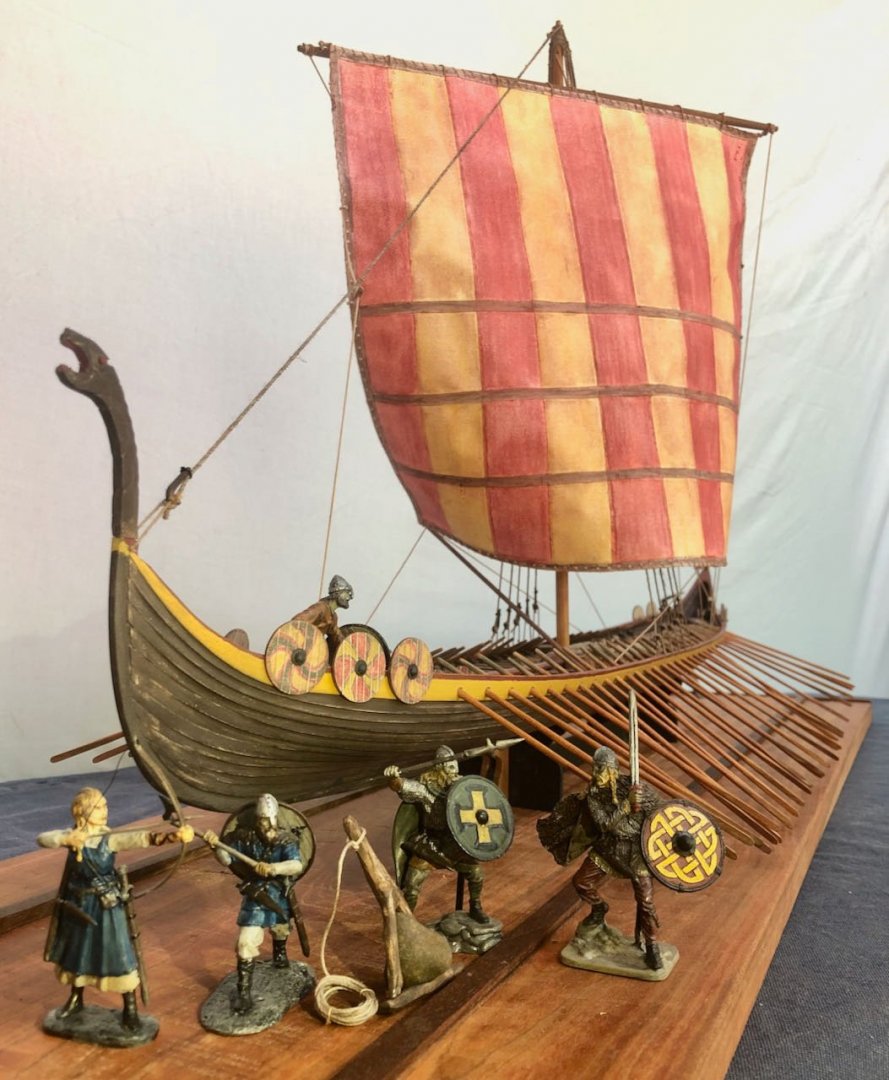
- mtaylor and Scottish Guy
-
 2
2
-
I apply each strip separately. Cut to fit as needed, smear wood glue on the tacky surface, apply, use a strip of wood or my finger to rub smooth and flat (sometimes bubbles get trapped), then move on to the next one.
Another benefit to doing it that way is that the tape itself is just tacky enough that sliding it into an exact position is tricky because it catches. A film of wood glue on the bottom means it slides effortlessly and can be adjusted to exactly where you want it, then snugged down with some gentle pressure.
-
Wefalck, I absolutely agree that tape on its own would not be a good idea, but recall that earlier I described how the masking tape is attached with a layer of carpenter's glue once it's cut to fit. The glue soaks into the tape and not only holds it quite solidly once dry, but stiffens it so that it's easier to trim. The paint provides another round of stiffener. The same method used on my Arabia has shown no signs of alteration in ~4 years of the highly variable environmental conditions within my house (from bone-dry firewood-heated air in winter to humid summer air only partly buffered by air conditioning, and temperature variations from the 50s-80s F). So I'm pretty comfortable with the method.
The venue is setting up large square tables, one for each model, so people can view them from all sides but they're not easily reachable (especially by little hands). Still a little nerve-wracking but worth it, I think.
- Canute, wefalck, Keith Black and 3 others
-
 6
6
-
A few shots of carefully working the masking-tape "canvas" around the rest of the boiler deck:
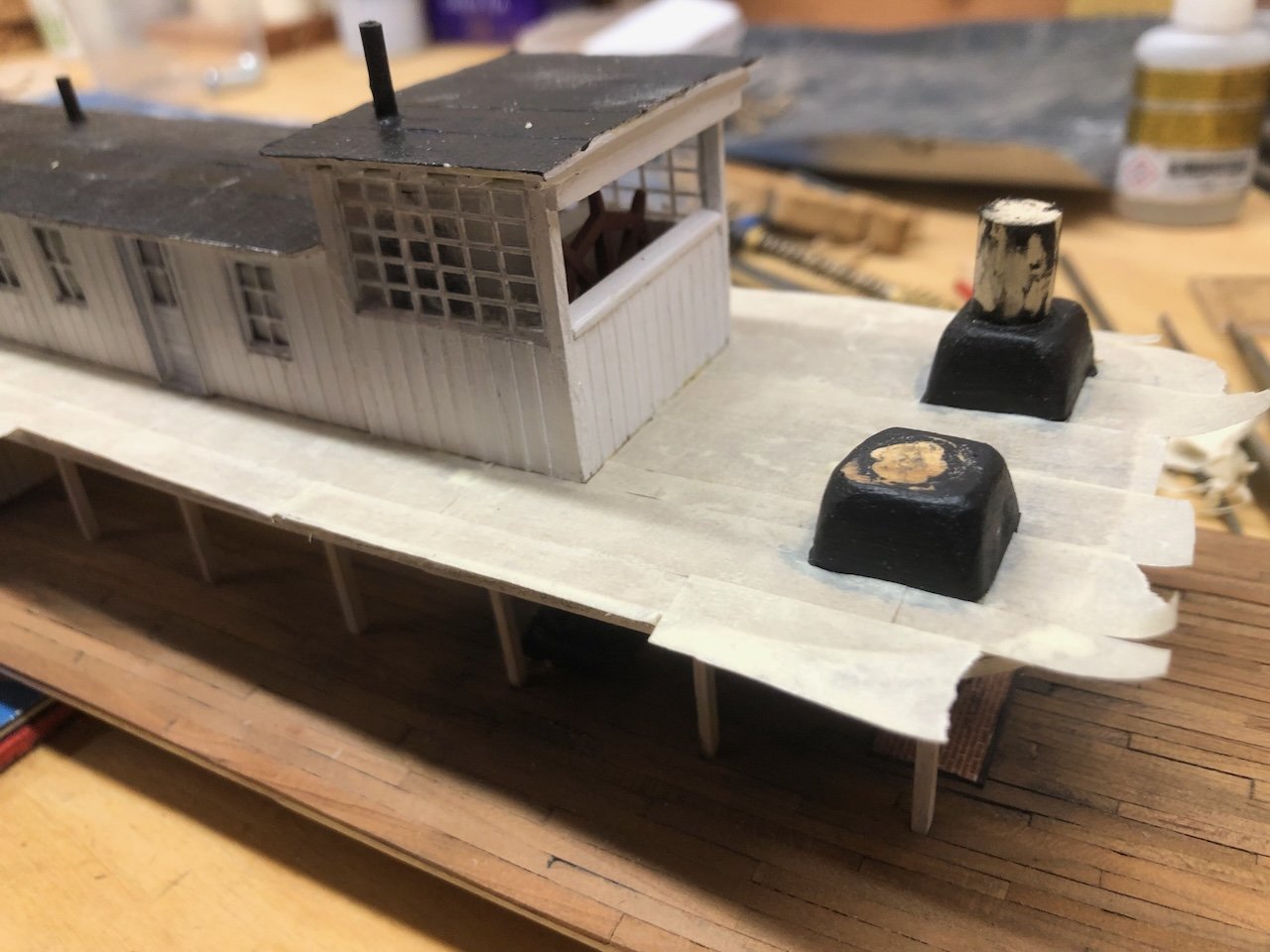
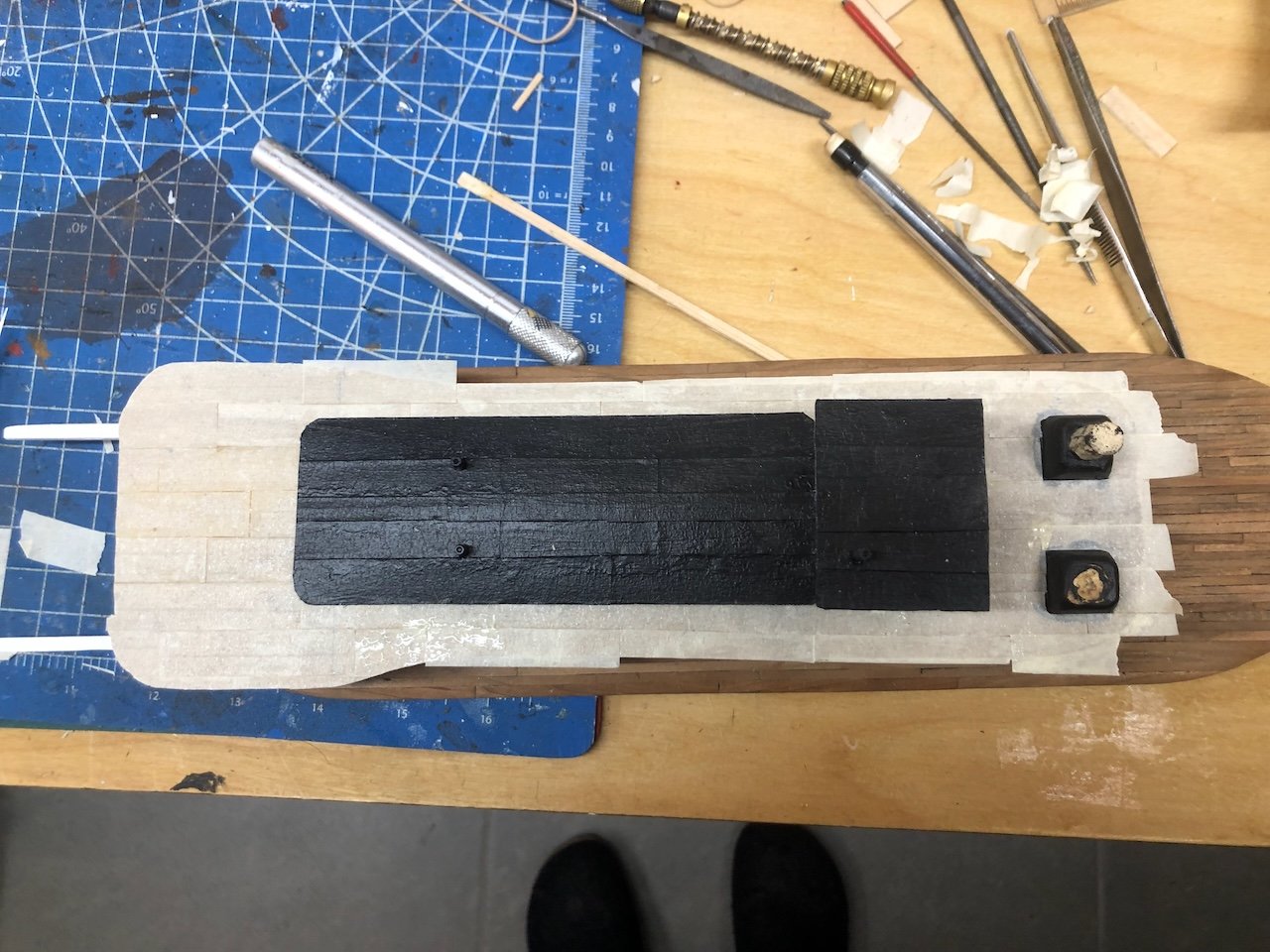
Lots of fiddly cutting and fitting here. But another benefit to masking tape is that it holds its shape stiffly and is easier to shape and fit than something floppier like silkspan or tissue. And it's just sticky enough on its own to stay put when you're trying to draw or cut a careful line, while still being easy to move when you want.
I finally reached the point where a bunch of these overlapping mini-projects all came together. So here she is with cabins and pilot house attached, deck fully canvassed and painted, hog chain posts installed, and stern planking applied.
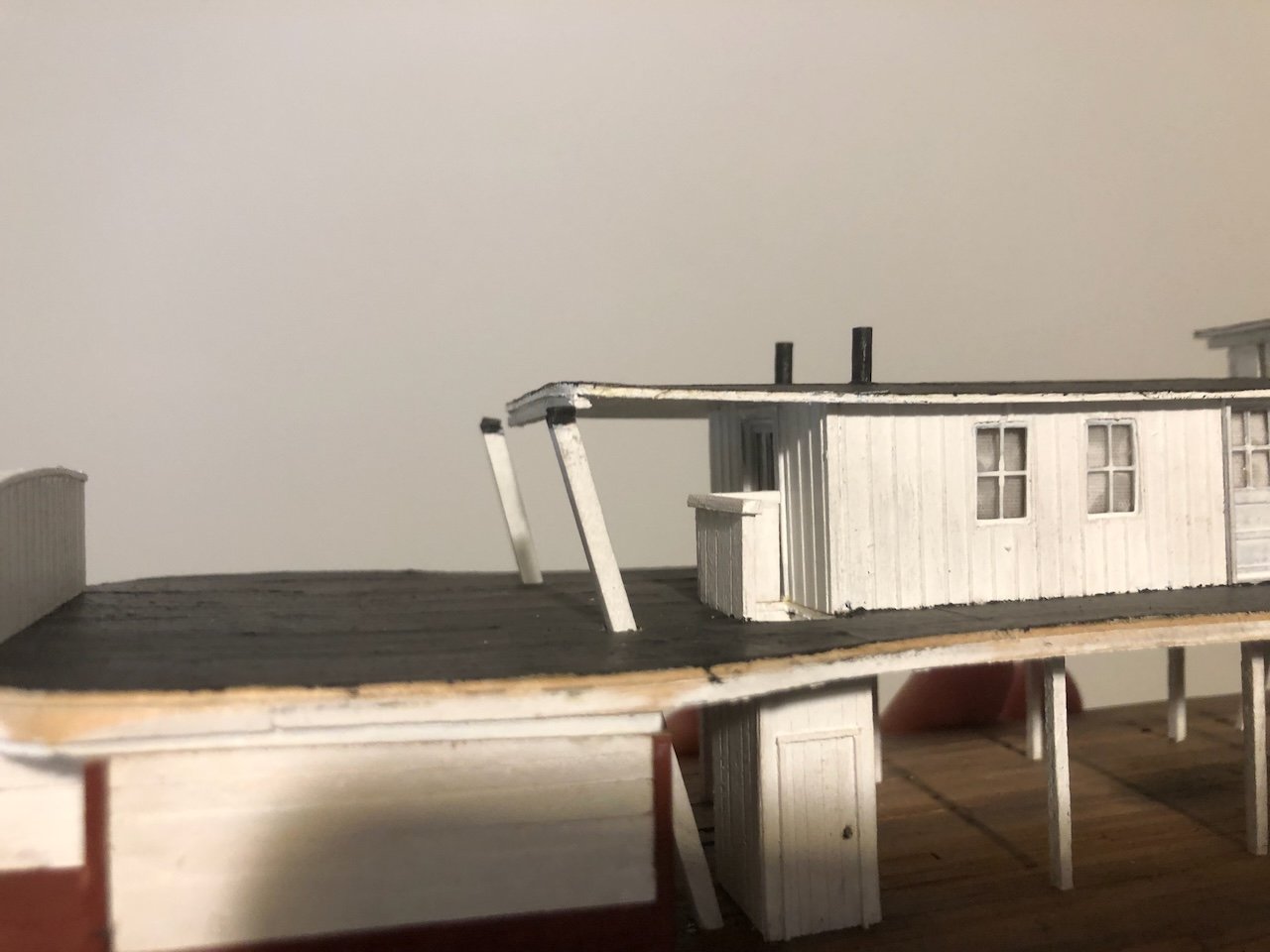
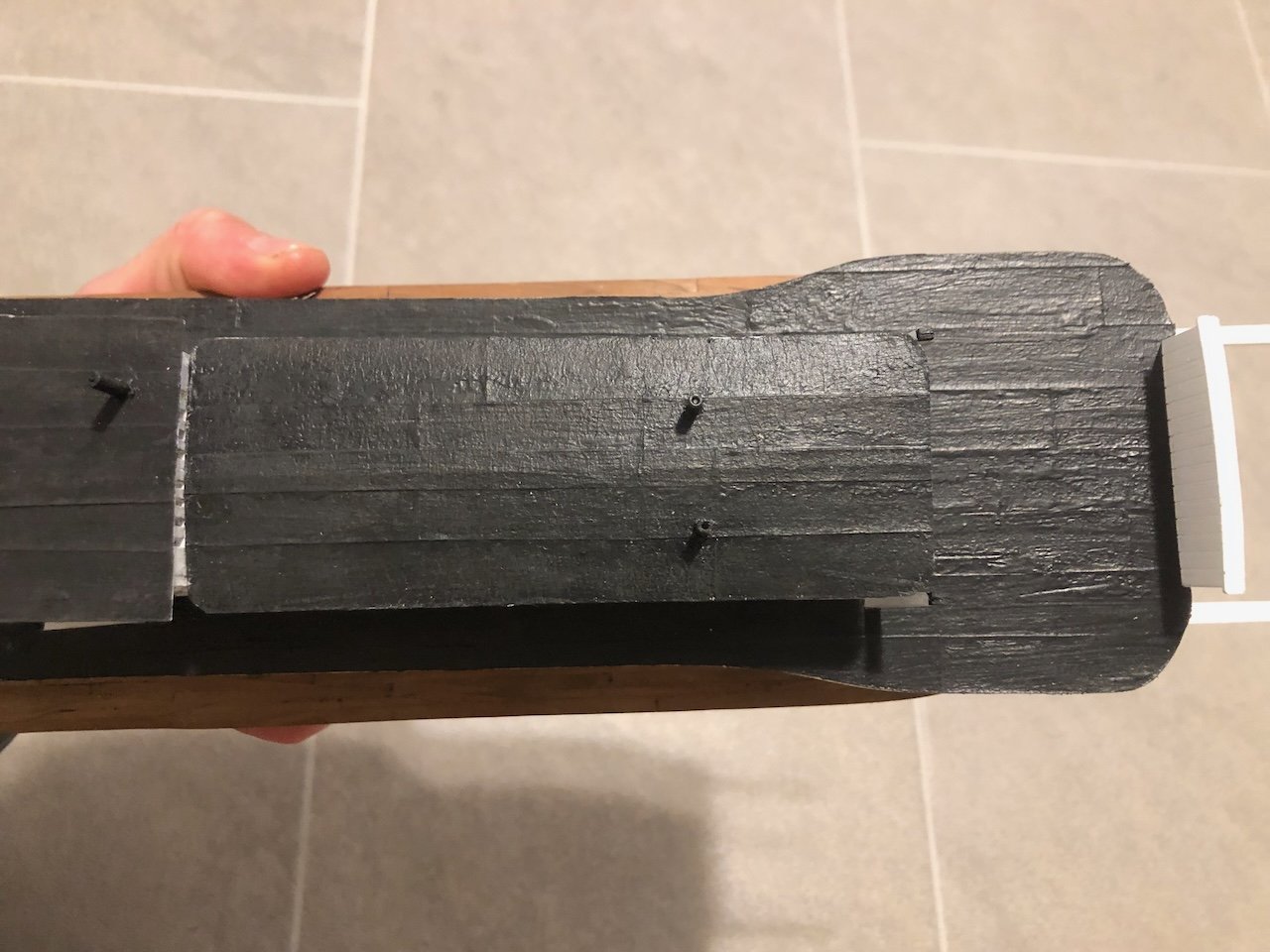
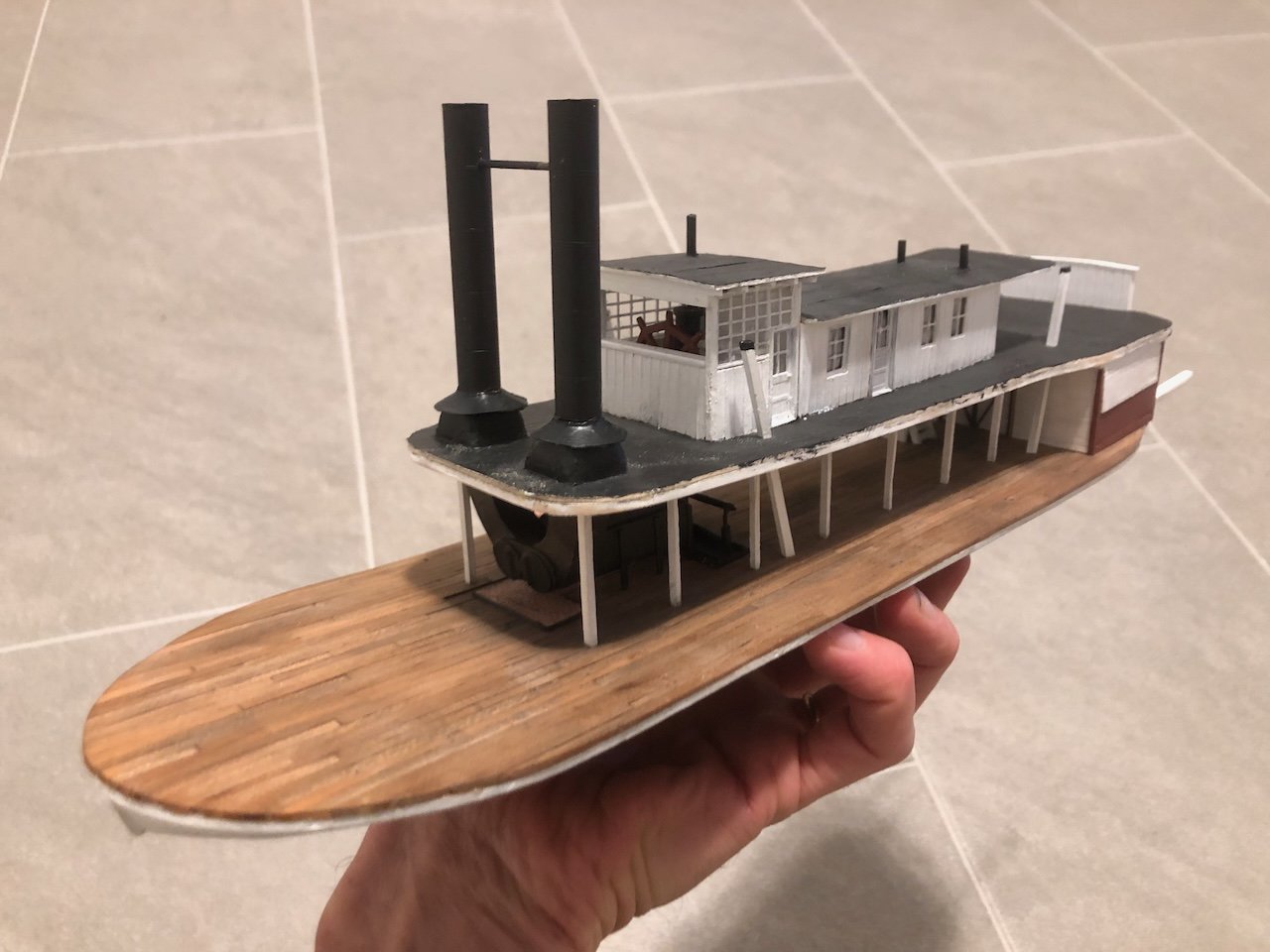
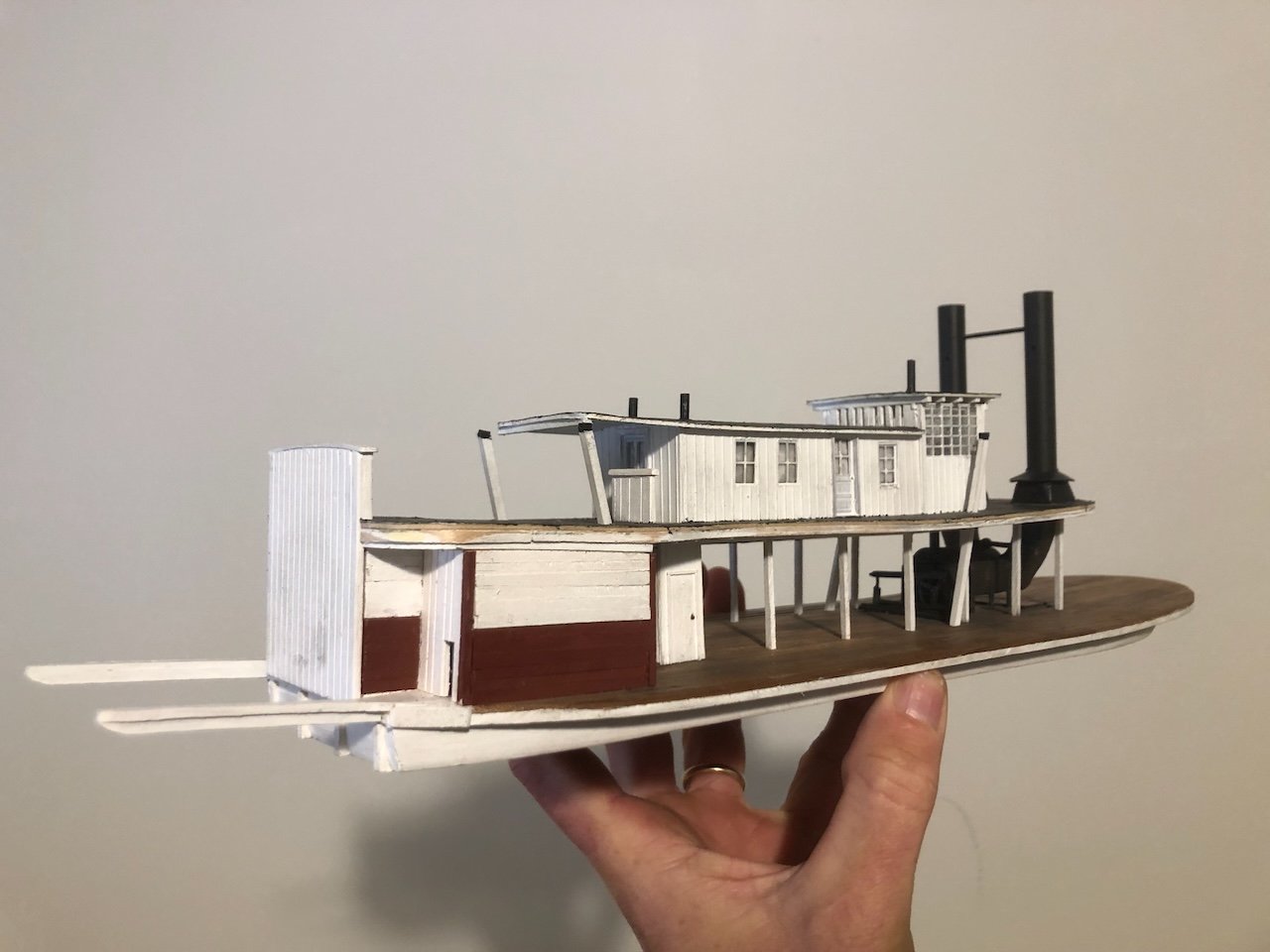
Careful eyes will notice that I haven't yet installed the support posts for the rear cabin roof overhang, but it's plenty stable for now. I'm not worried about the messy appearance of the boiler deck's edge because that will get wrapped in a thin plank veneer.
On Sunday, I'll be giving a talk on the evolution of steamboat design along the Missouri River, at a regional cultural center that specializes in supporting educational and artistic programming. I initially developed this talk back in 2021 as an online lecture for a regional non-profit that works along the Missouri River (you can view the talk recording here if interested), but this will be the first time I've given it to an in-person audience. As a bonus, I'll be displaying three of my steamboat models, the first time any of them have been presented to the public. Here they are all lined up and ready to go:
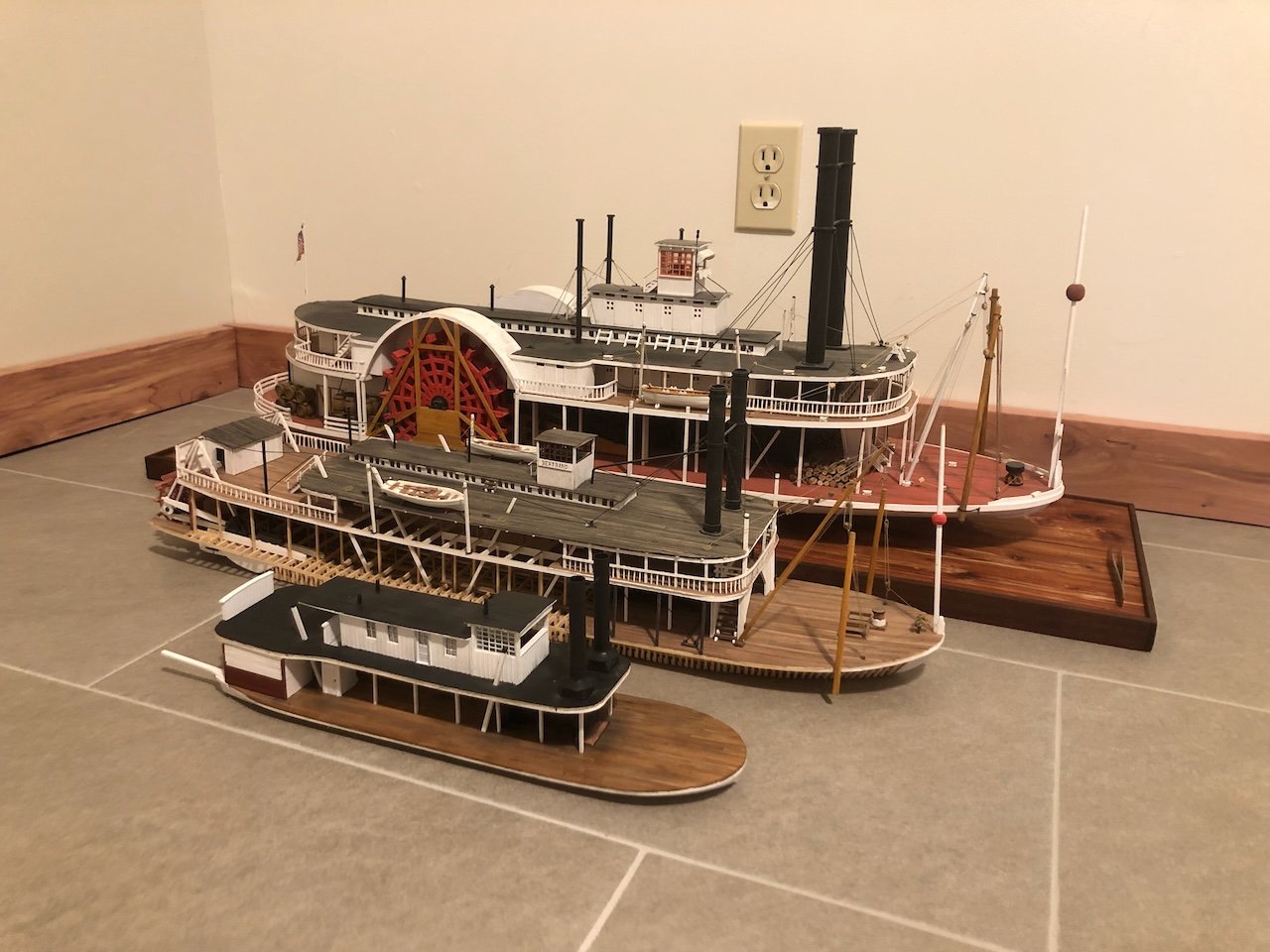
In the back is Arabia (1:64), in the middle is Bertrand (1:87), and of course in the foreground is Peerless (1:87). All three operated on the Missouri River, from 1853-1856, 1864-1865, and 1893-1903, respectively.
Model size is misleading, as Arabia is at a larger scale though she's actually very close in size to Bertrand. On the other hand, Bertrand and Peerless are the same scale, so you can really see how tiny the latter was in comparison to her ancestors.
This talk has been scheduled for a long time, and I'd originally hoped to have Peerless done for this talk, but when it became clear that wouldn't happen, I aimed to at least reach a clearly presentable and semi-complete stage, which I just barely did!
Thanks as always for following along, and helping me get to this point.
-
While no expert, I've personally found that I like to do both. An initial blackening in highly diluted solution, followed by painting. The blackening seems to rough up the surface slightly and the paint grips better and looks more natural than when applied straight to brass. I've also used primer followed by paint but that ends up thicker than I like.
-
Quality instructions or not is a HUGE divider for kit manufacturers. There are only a handful that really bother to do it right. The rest are a sink or swim mentality.
- Ryland Craze, Canute, Scottish Guy and 1 other
-
 4
4
-
Time for a big dump of progress photos!
I completely failed to take photos of building the roof for the pilot house and cabin, but it wasn't complicated. I just cut a thin sheet of wood to the shape I wanted, spread glue on the "rafters", and secured everything with rubber bands.
The photo story picks up again as I applied the simulated canvas. I used the same method as I did on Arabia: strips of masking tape held down with a thin layer of wood glue. When that's dried overnight, I trim the edges and paint it. It's held up perfectly on that last model, I really like the texture, and it's more forgiving to work with than tissue paper or silkspan or other options. Plus it's dirt cheap. Here's a sequence showing the progression of slightly overlapping layers on the gently arching cabin roof:
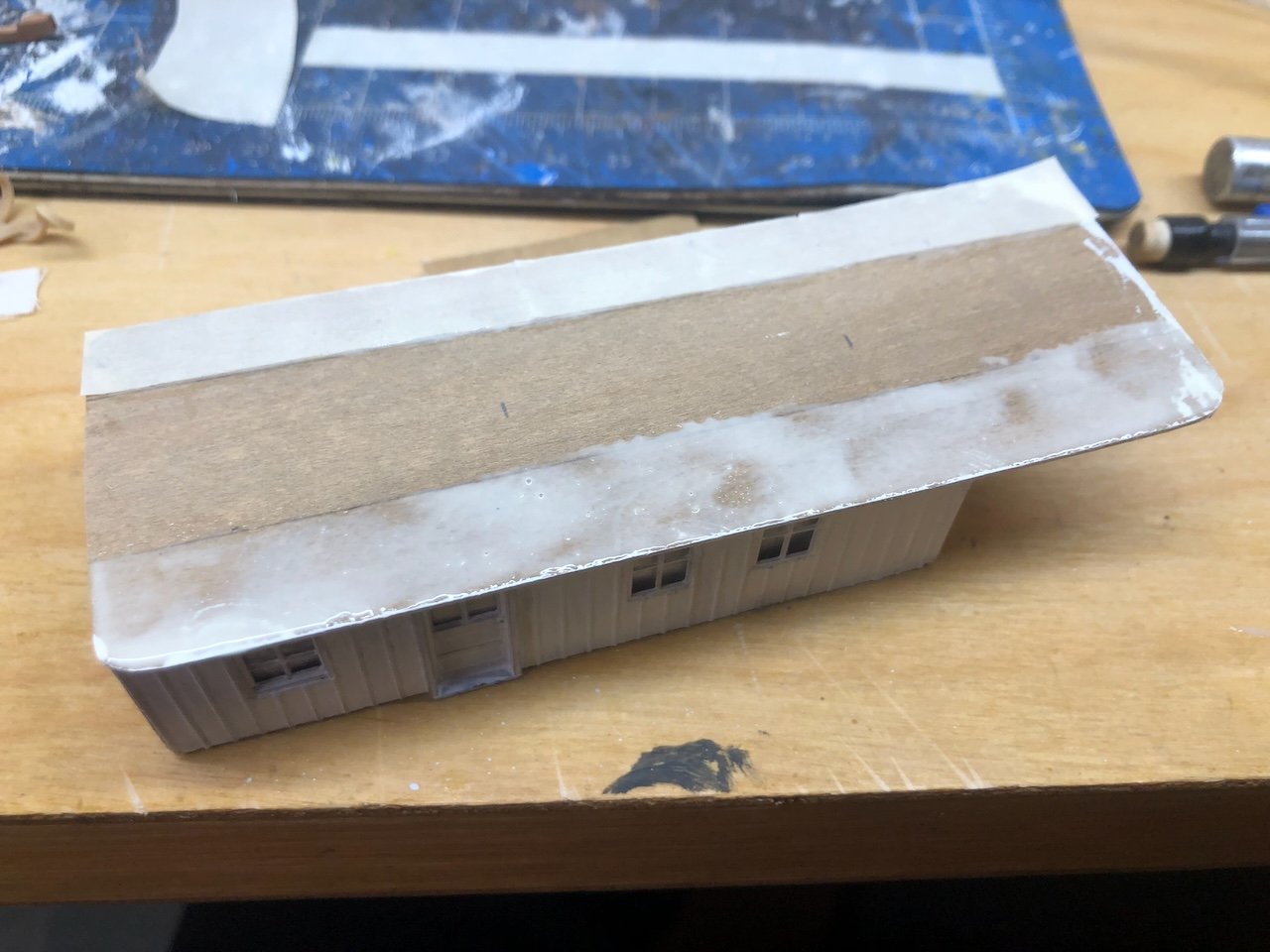
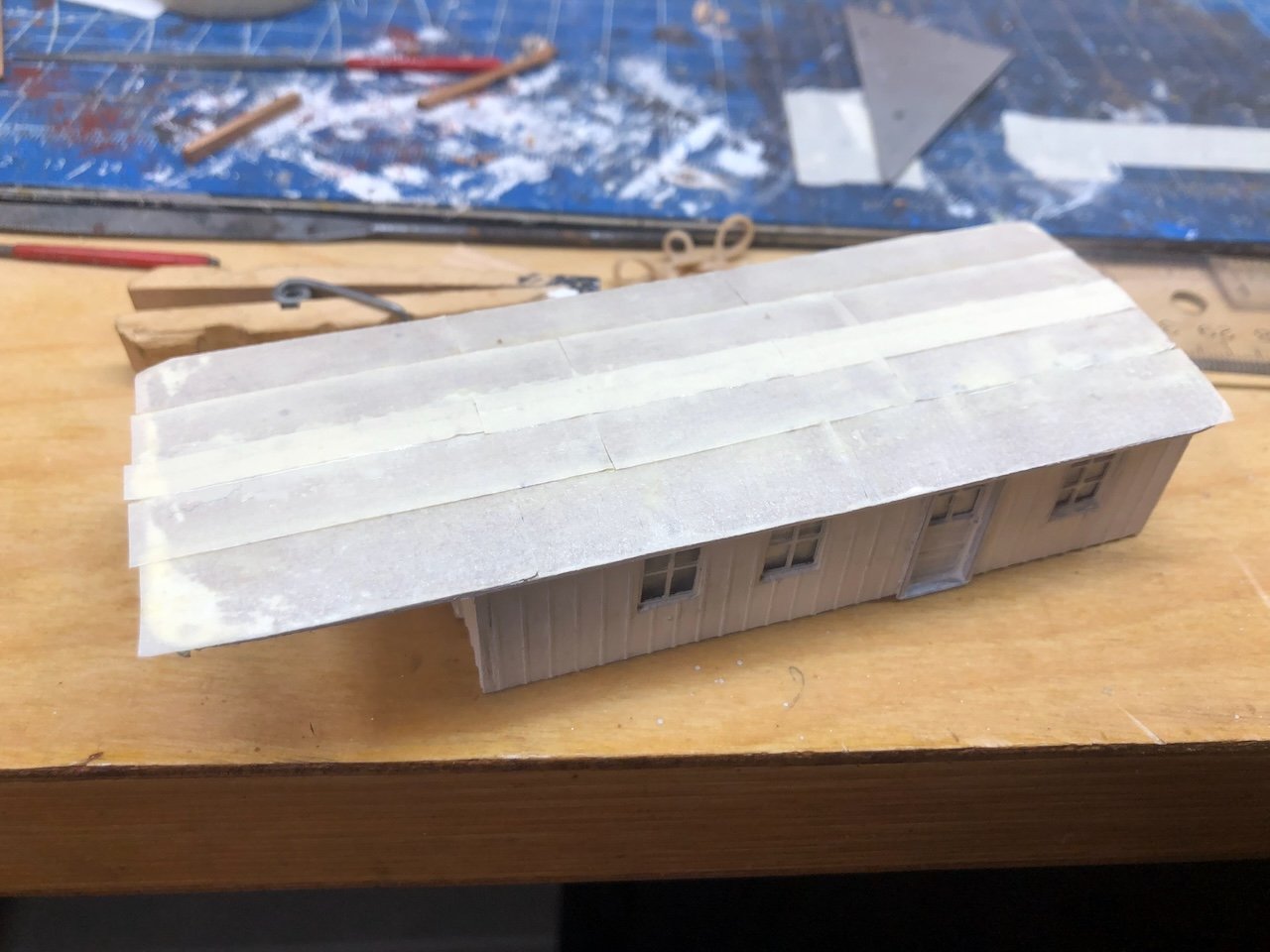
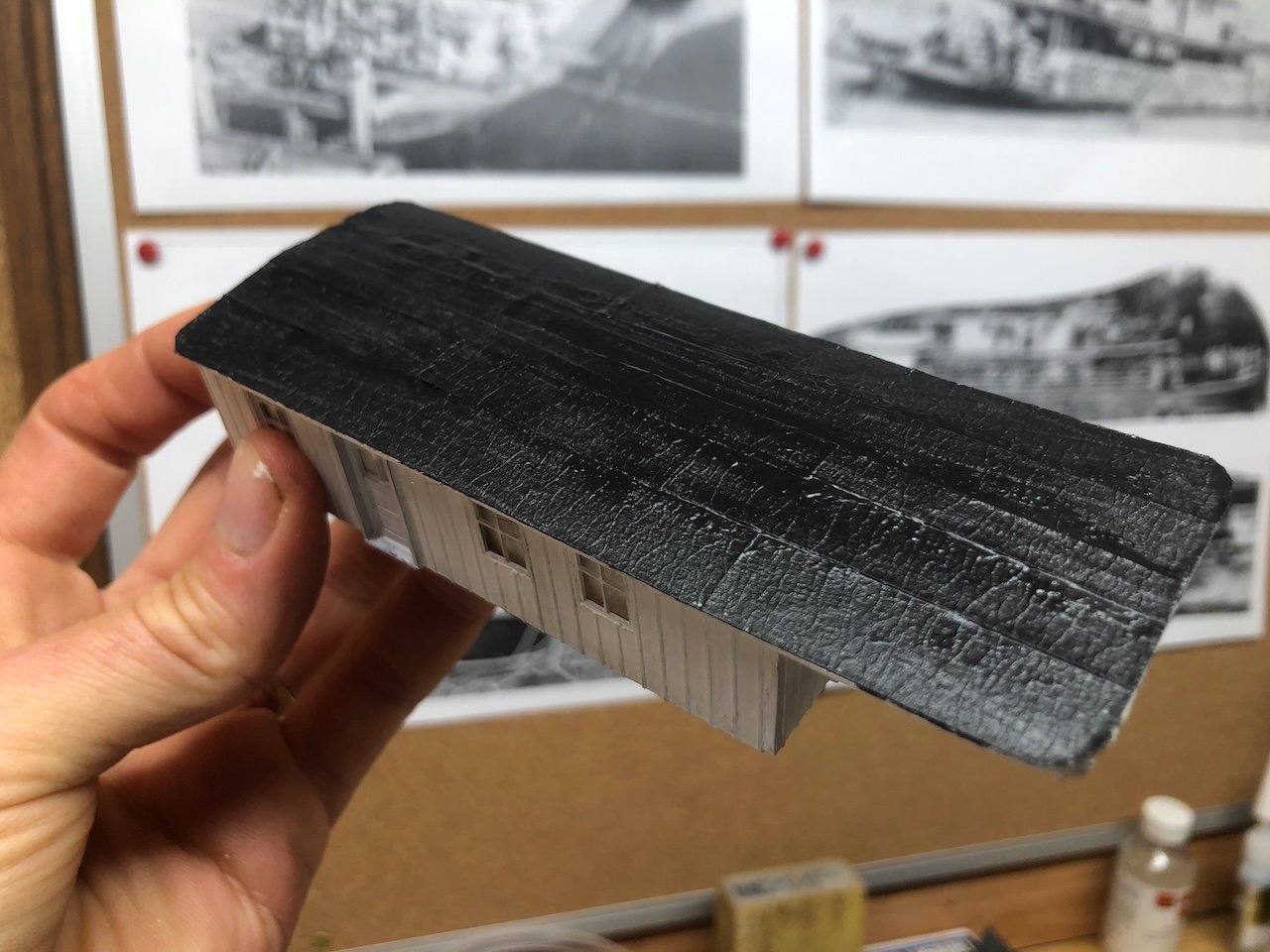
And the same for the pilot house:
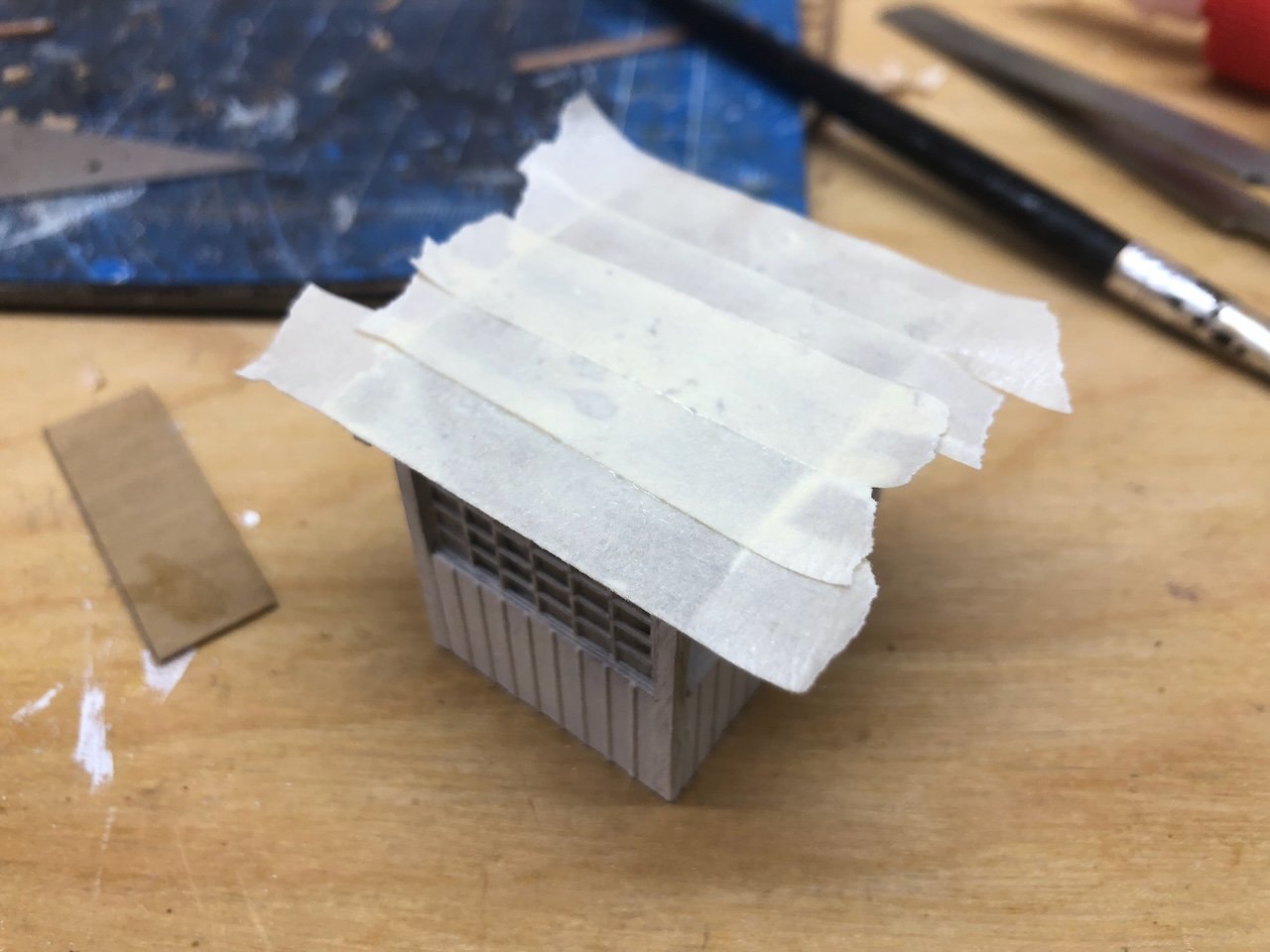
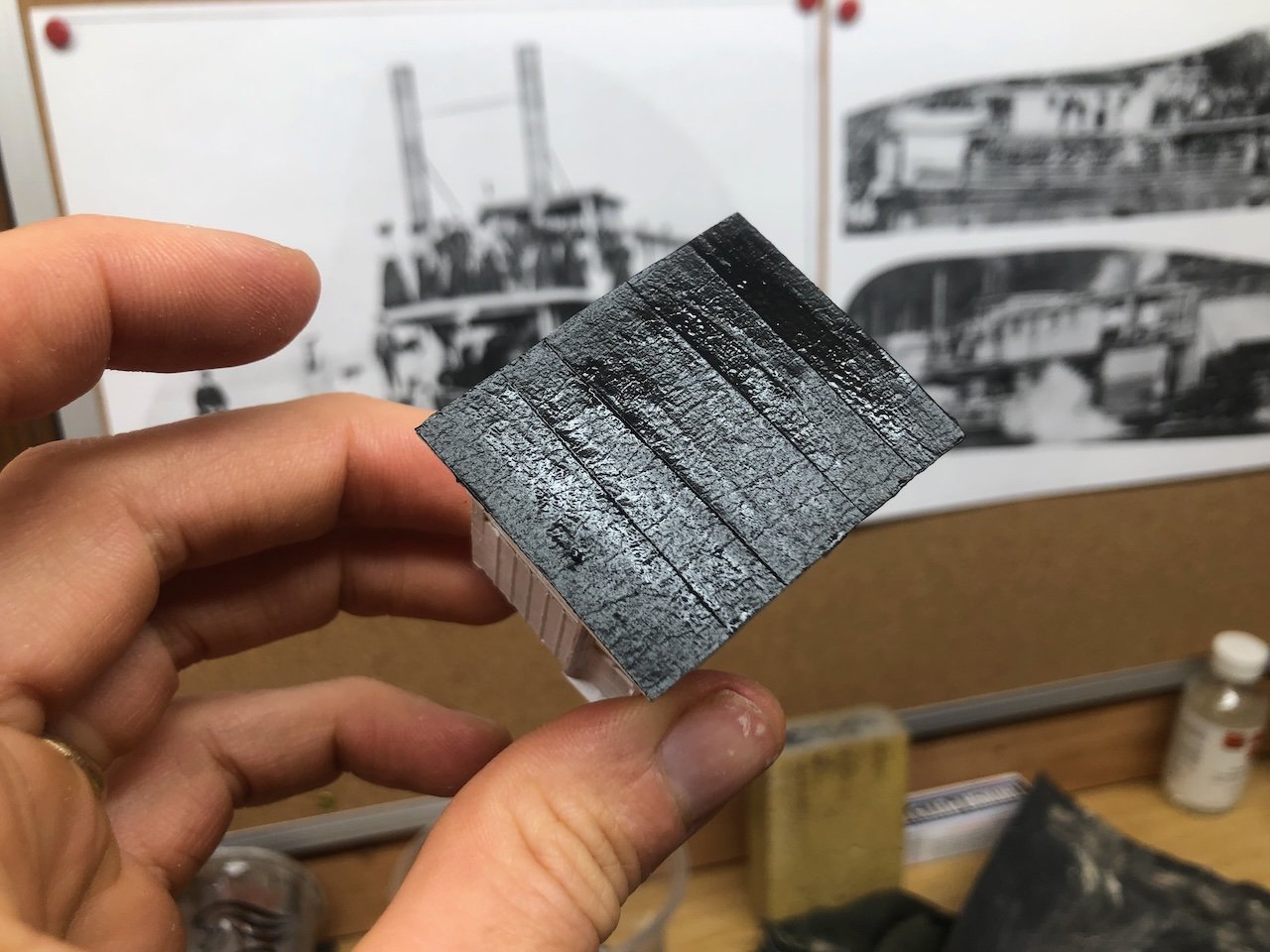
I'll use some pastels to weather this a little, dull it down, and give it some subtle variation in tone.
In the meantime I worked on laying out the support posts for the hog chains, which needed to be carefully situated to run just along the outside edge of the cabin roof. So I marked the final location of the cabin and carefully laid out where I wanted the posts to go through the boiler deck. Then I drilled a series of small holes and used a sharp knife tip and then small files to make the final shape:
I then made a simple jig for the angle I wanted the posts to sit at, and used this to set them up. Here they've already been cut and painted. The black tips are meant to represent the iron caps that actually held the hog chains onto the wooden posts.
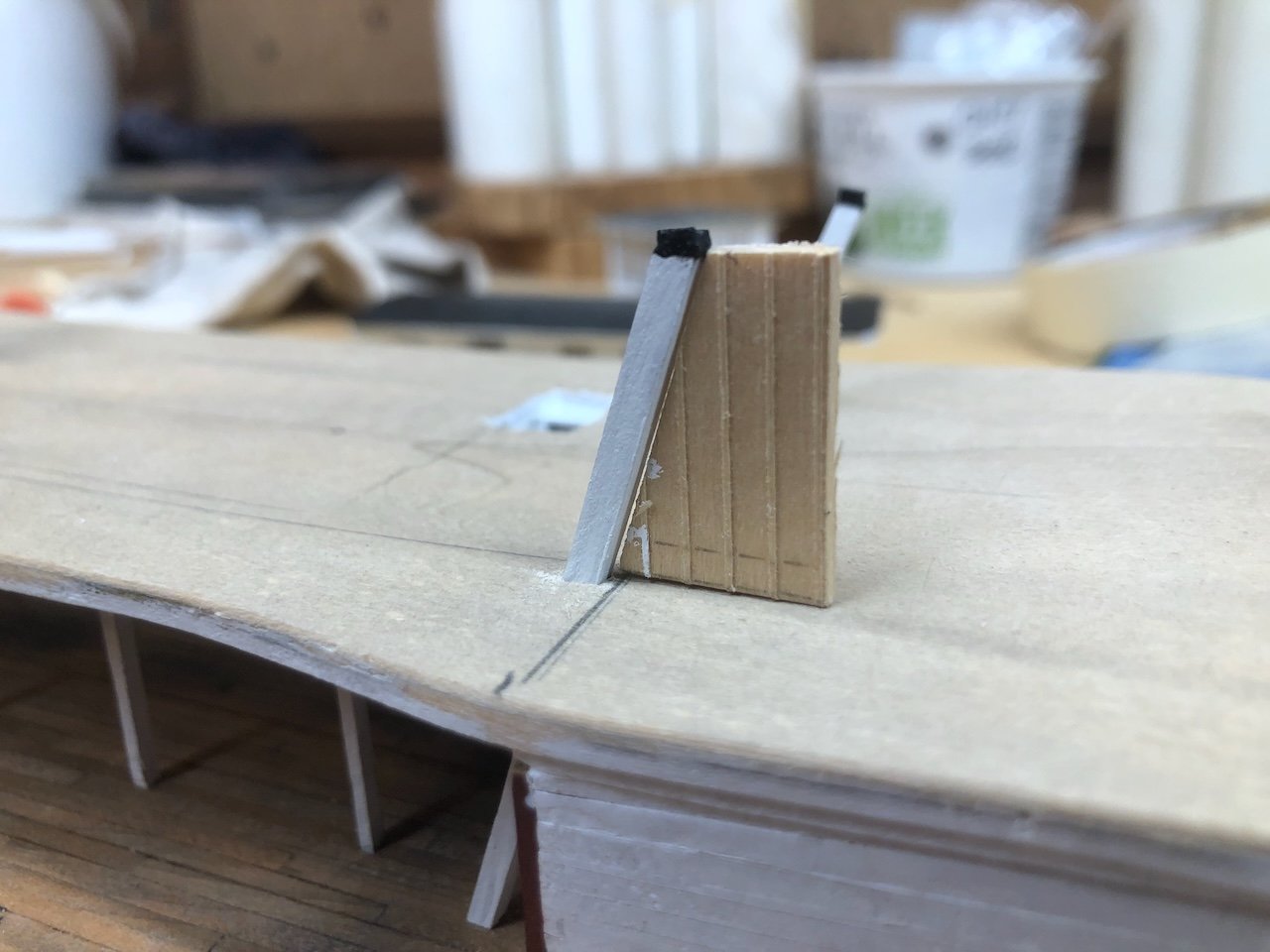
And here are a few shots of the fore and aft hog chain posts resting in place (not yet glued); you'll notice I temporarily removed the chimneys to avoid any possible damage as I worked on all this:
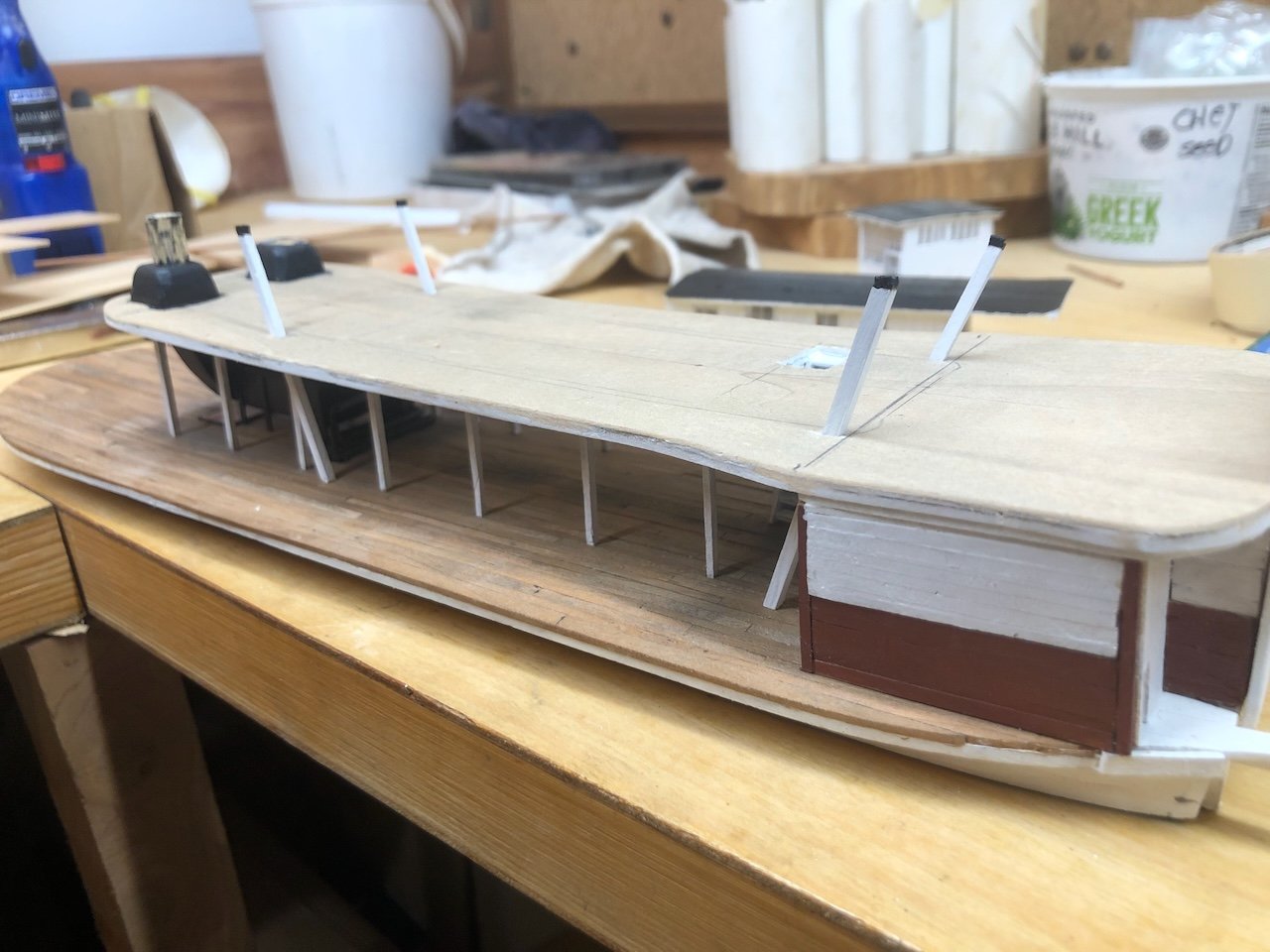
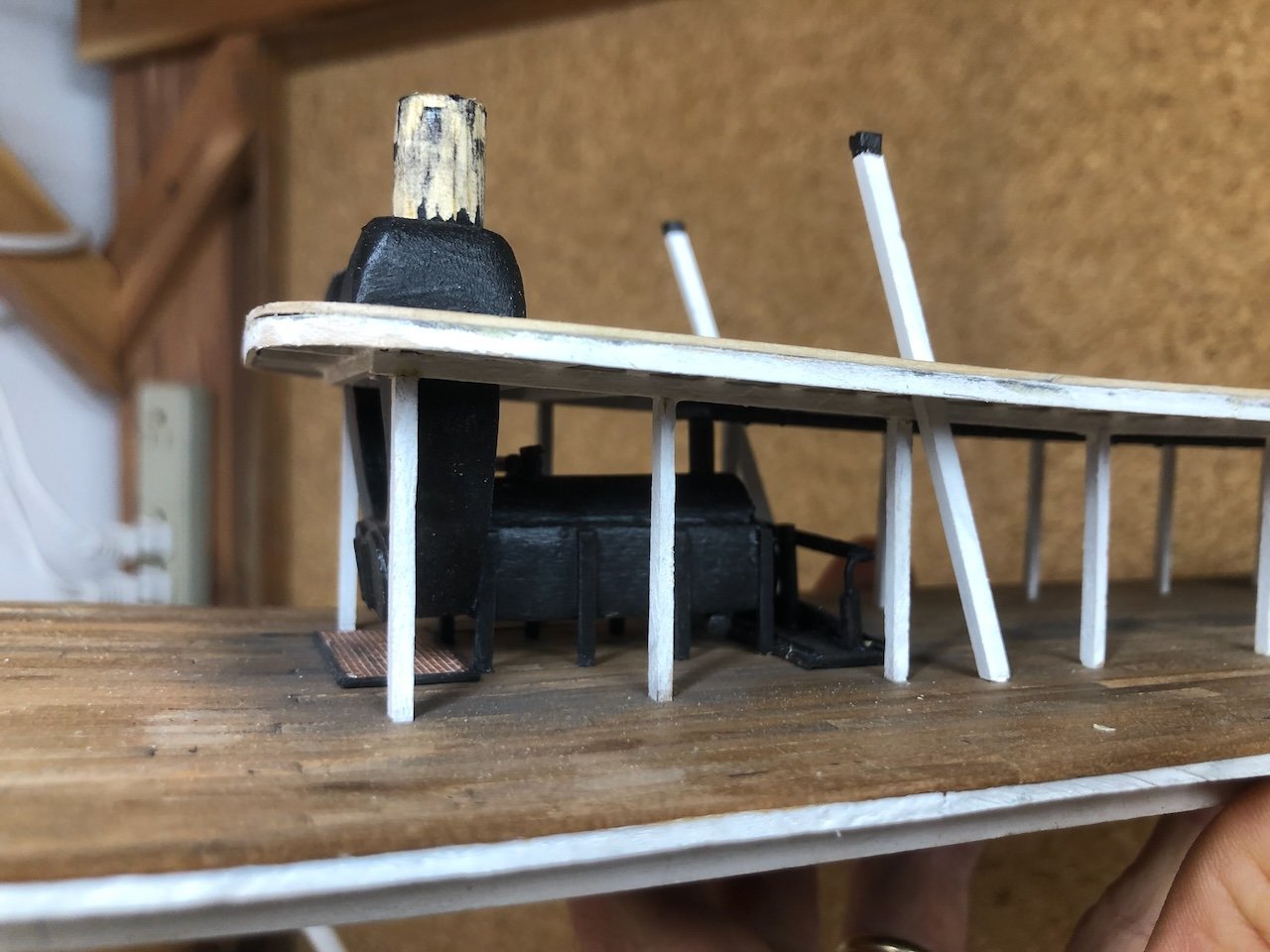
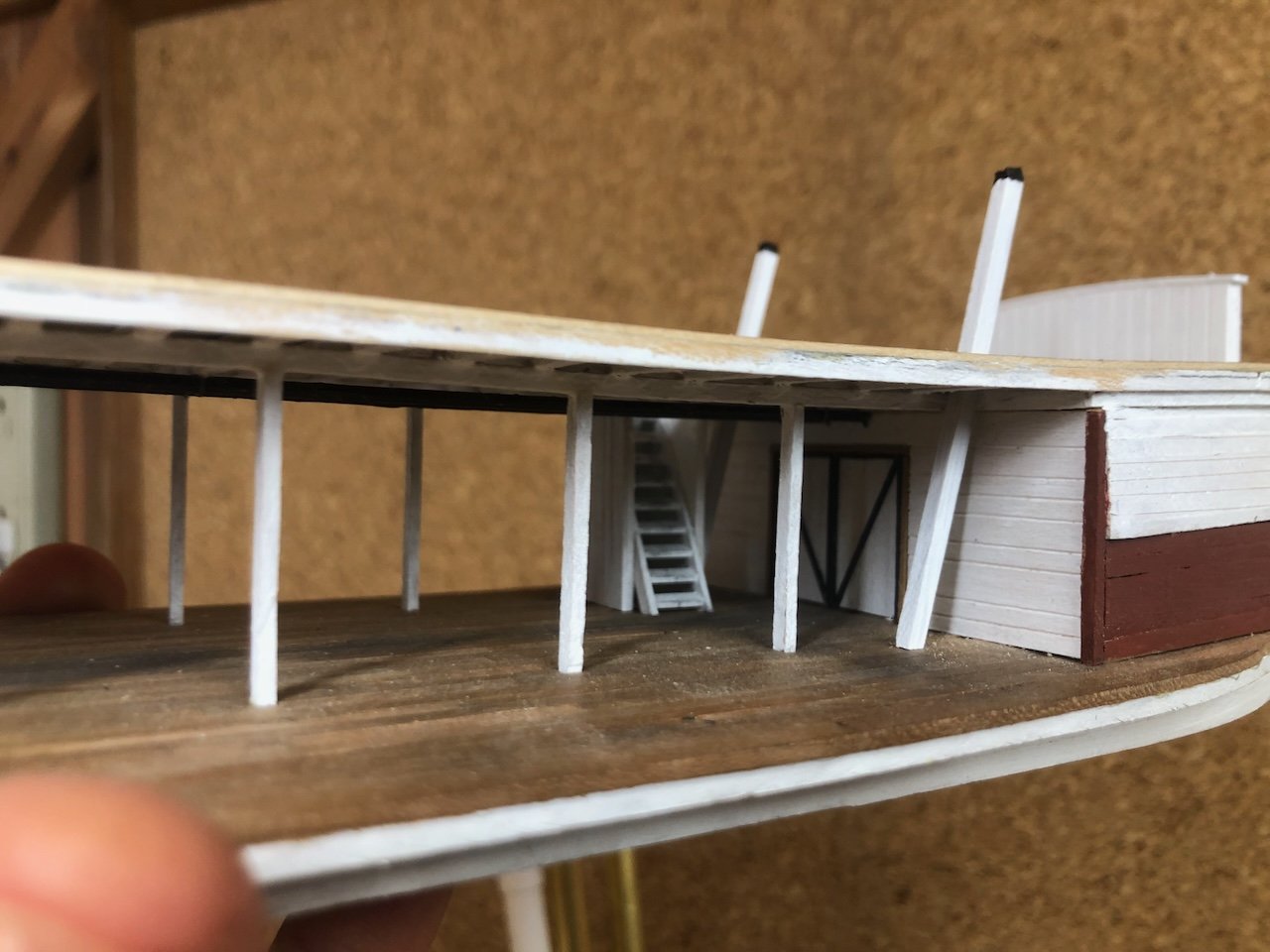
I also built the assembly that goes over the stern, which I'd left off until now since it rises above the boiler deck and I didn't want to bump or snap it while doing earlier work on the deck.
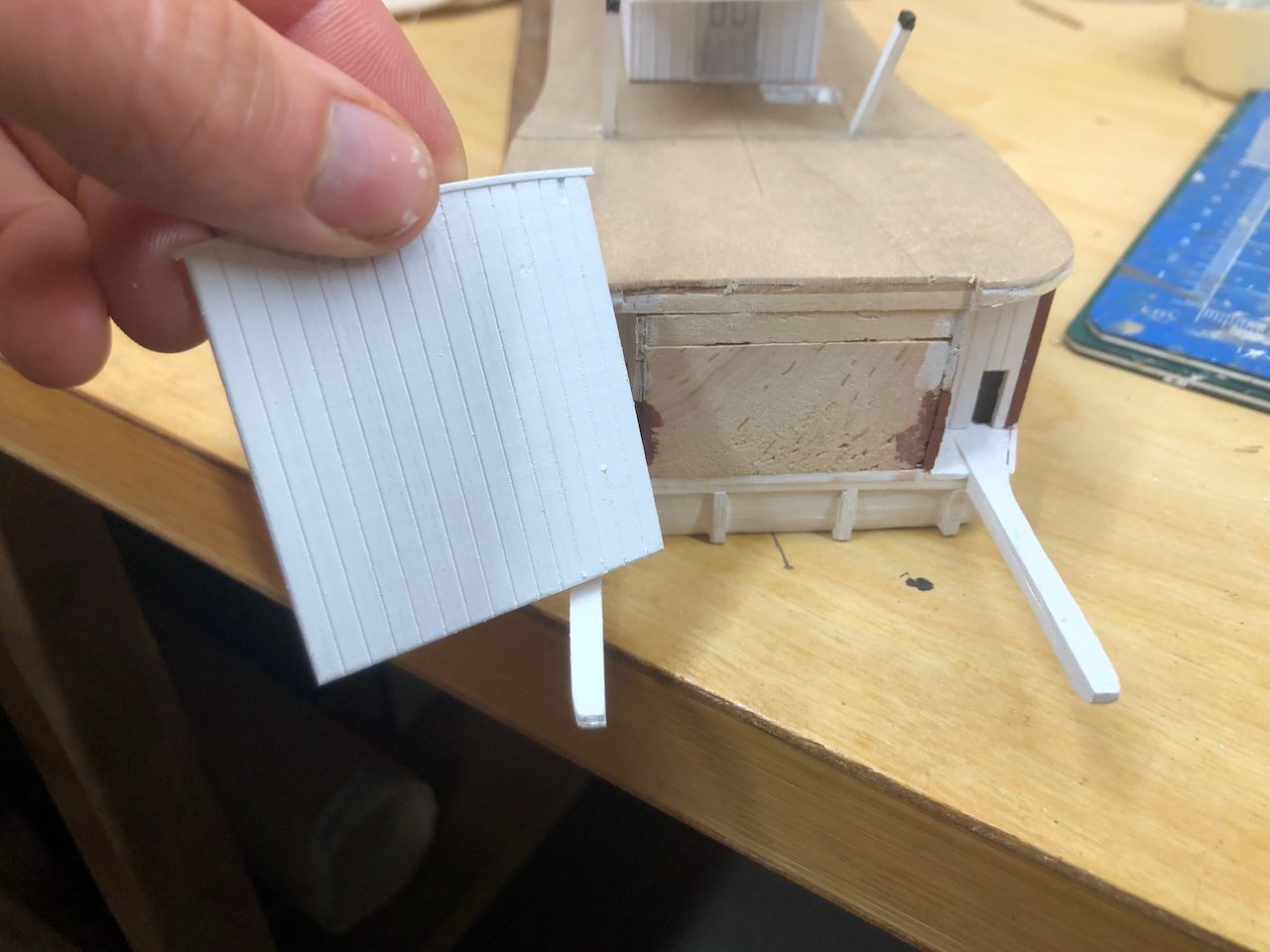
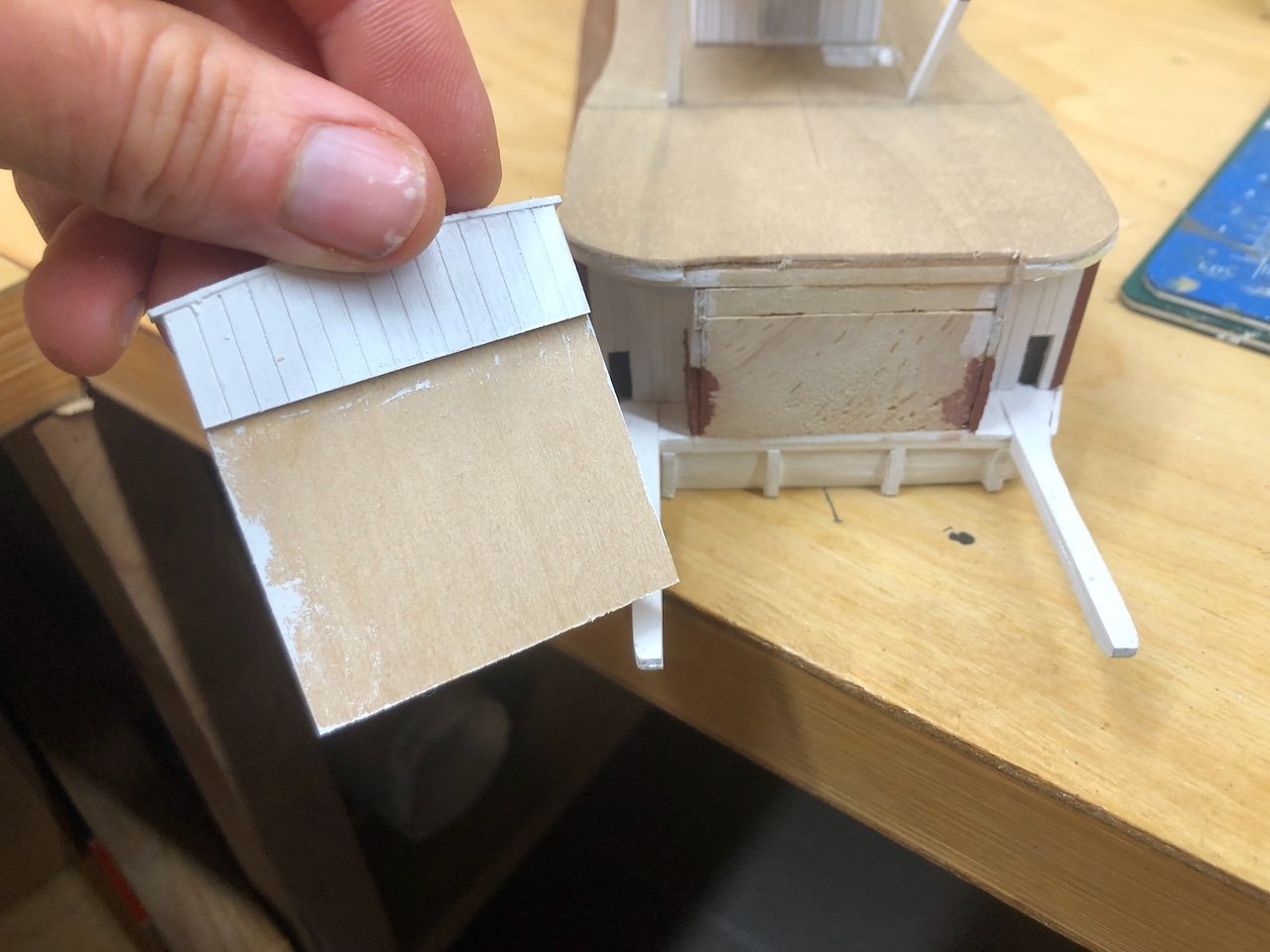
Finally it was time to start attaching things for good. Here I've glued down the cabin and pilot house (big step!):
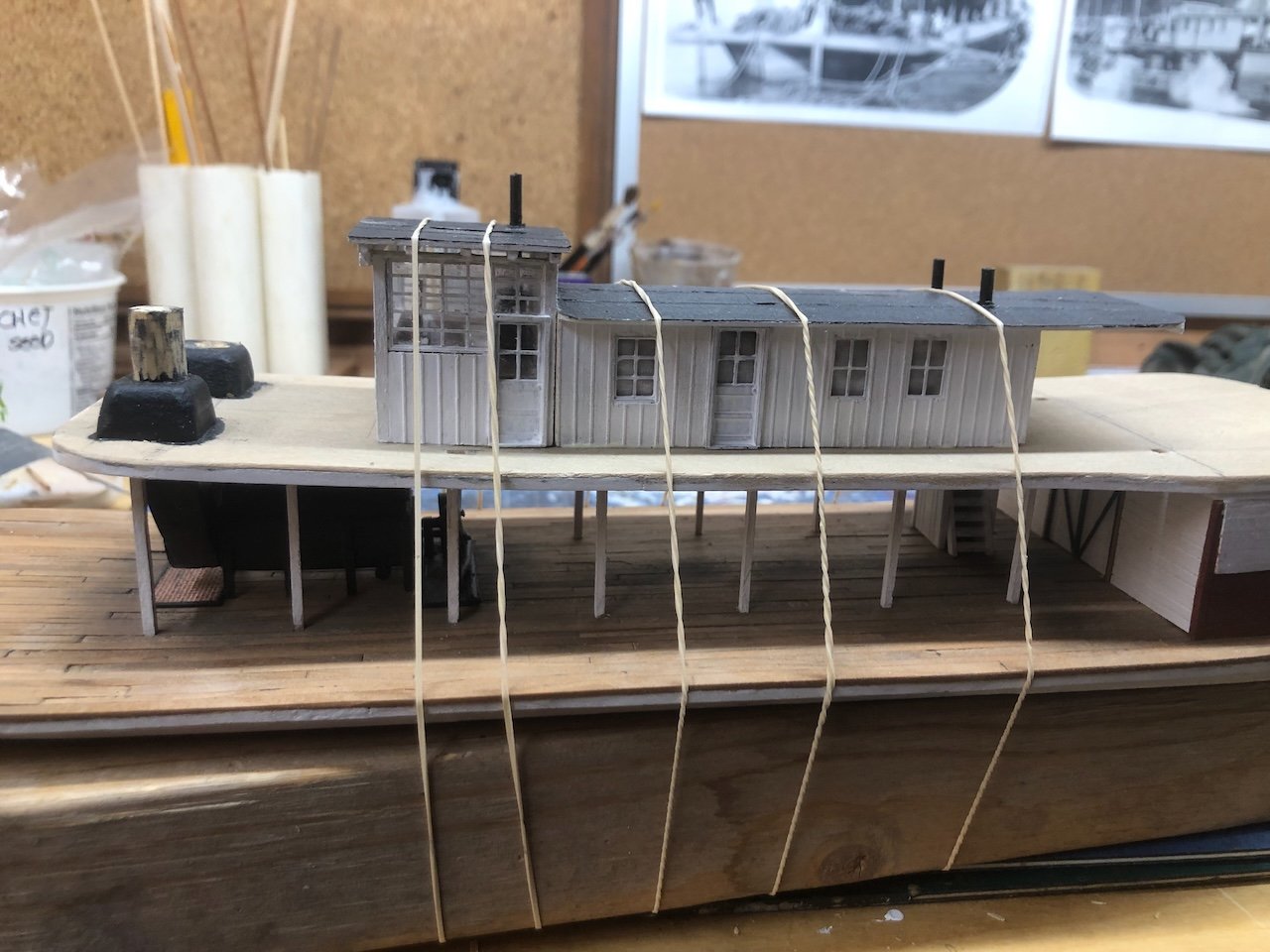
And while that was drying I got started laying down the "canvas" on the boiler deck, working up to the aft part of the cabin. I'll let this all dry completely before proceeding up either side of the cabin.
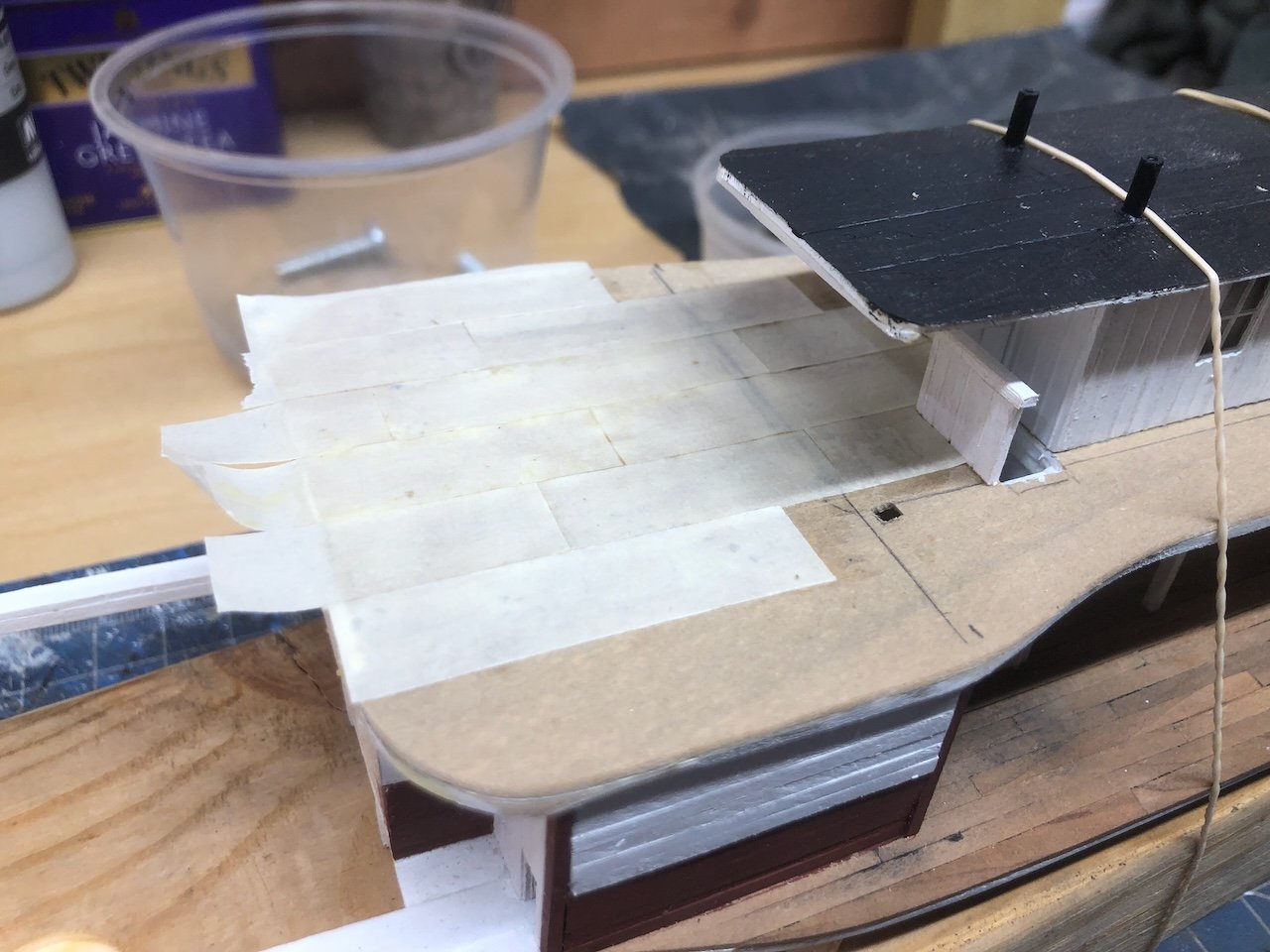
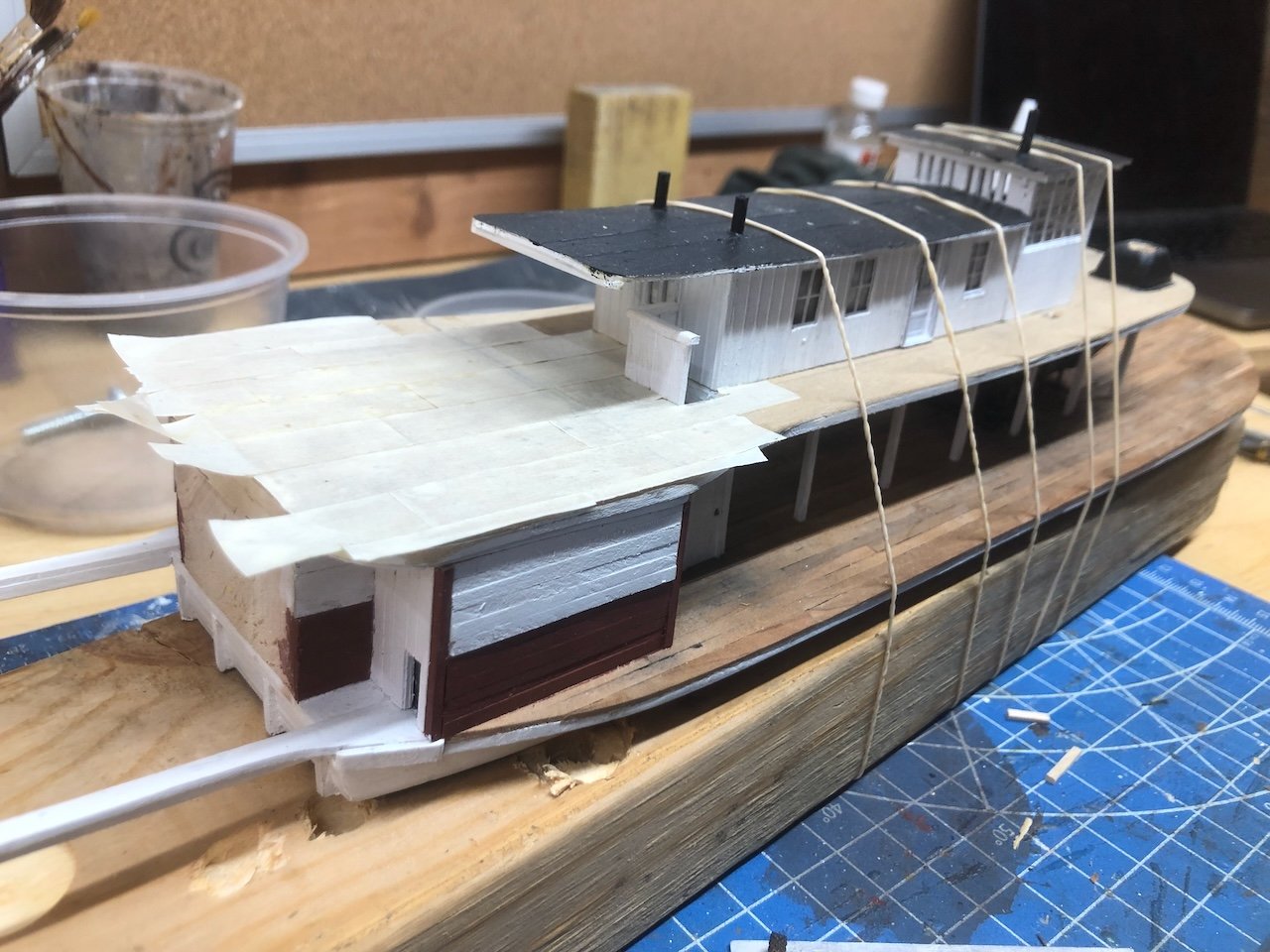
A close look will also show that I built and attached the little L-shaped guard wall around the staircase up to the boiler deck.
Once all the boiler deck canvas is laid, I'll (re)cut the hog chain post holes, paint it carefully (trying to avoid the cabin walls), then attach the stern piece. At that point the model will really be coming together though a lot of detail work remains to be done (not to mention the paddle wheel, which I'm dreading).
Thanks for reading (or at least skimming) through that big dump of updates!
-
-
Hey, great to see you're still working on this. Nice progress!
- mtaylor, Canute and Keith Black
-
 3
3
-
-
-
One of the things I love and occasionally fear about this hobby is the opportunity for constant learning. It can be both maddening and rewarding to recognize a need or desire to improve on something one's already done! You're doing a great job of keeping this balance in stride and your work looks great!
-
Well, I said I'd work on either the hog chains or the main cabin, and for once I stuck to the plan.
Building the rest of the cabin was mercifully straightforward, to the point that I didn't take many in-progress shots. I used some sheets of board-and-batten wood left over from past model railroad projects to lay out the walls, and scavenged close-enough windows from my scrap box. Here are the walls well underway, showing the bracing in the back and the carefully cut-and-fit holes for inserting the windows:
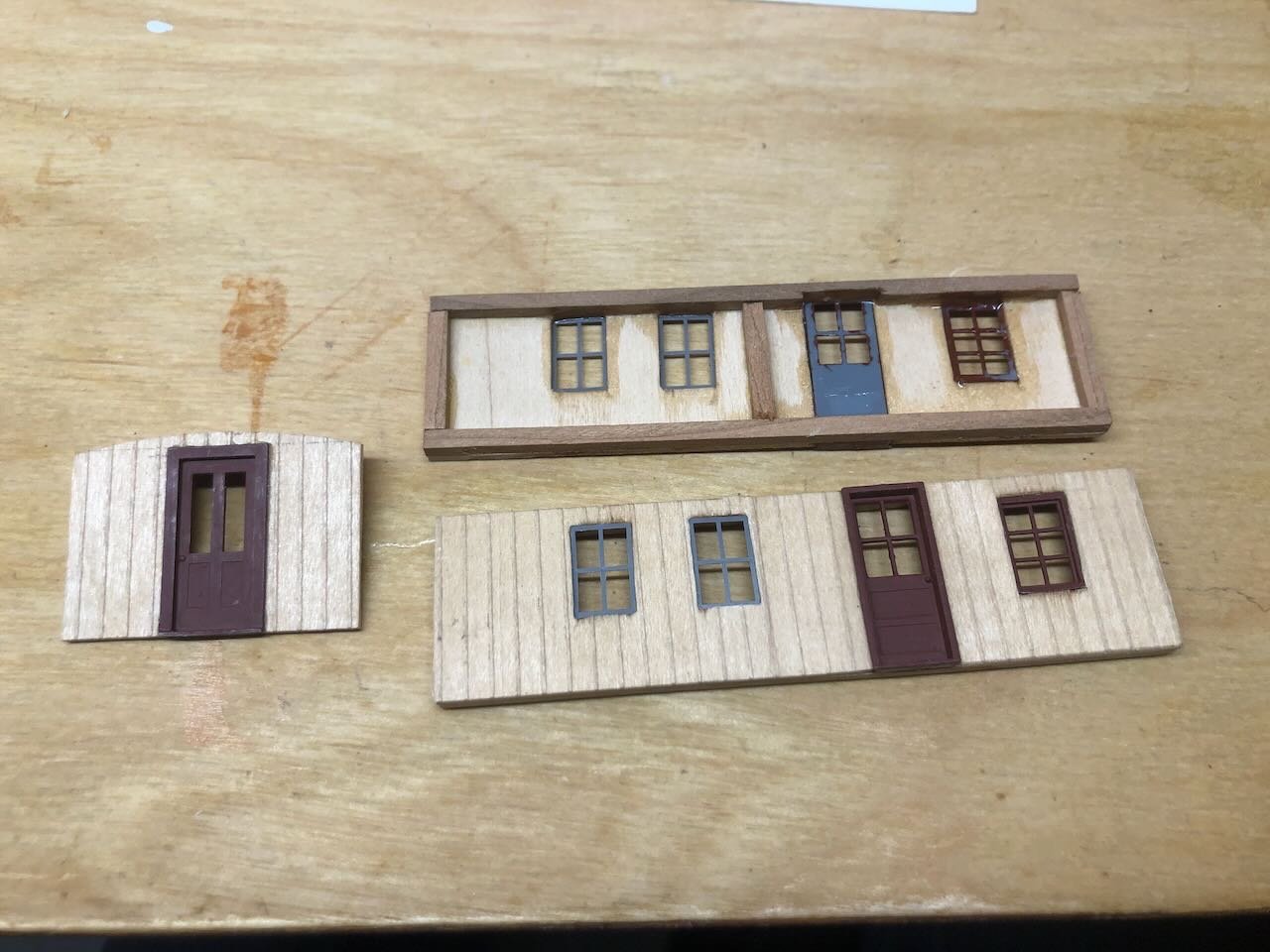
I painted everything white, then glassed in the windows the same way as the pilot house (CA plus scrap clear packaging), then added shades using some old sailcloth material from a past ship kit. When that was done, I assembled the structure using my magnetic squaring jig:
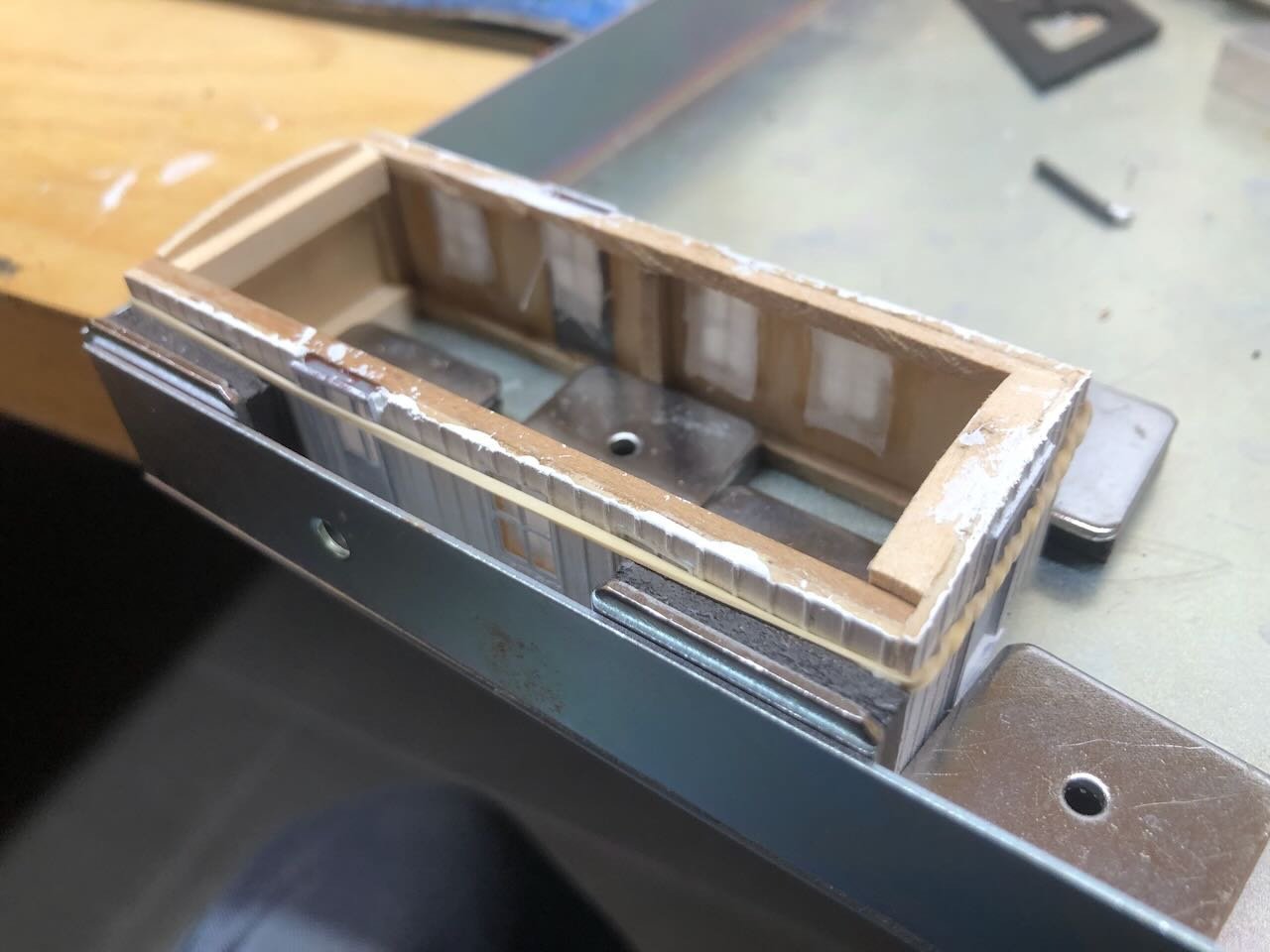
And here's the result:
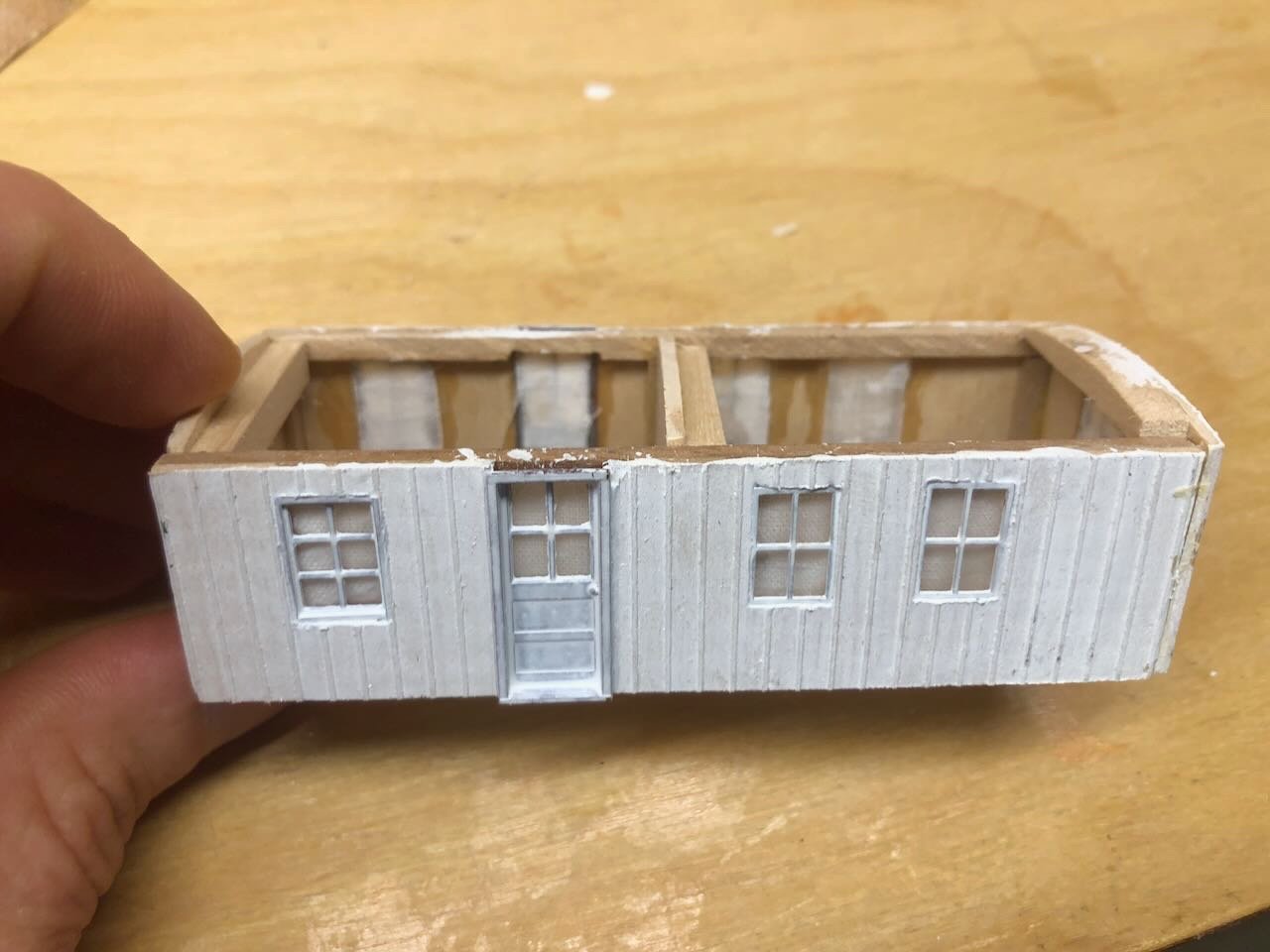
Here's the cabin test-fit on the rest of the model, with relevant photos in the background:
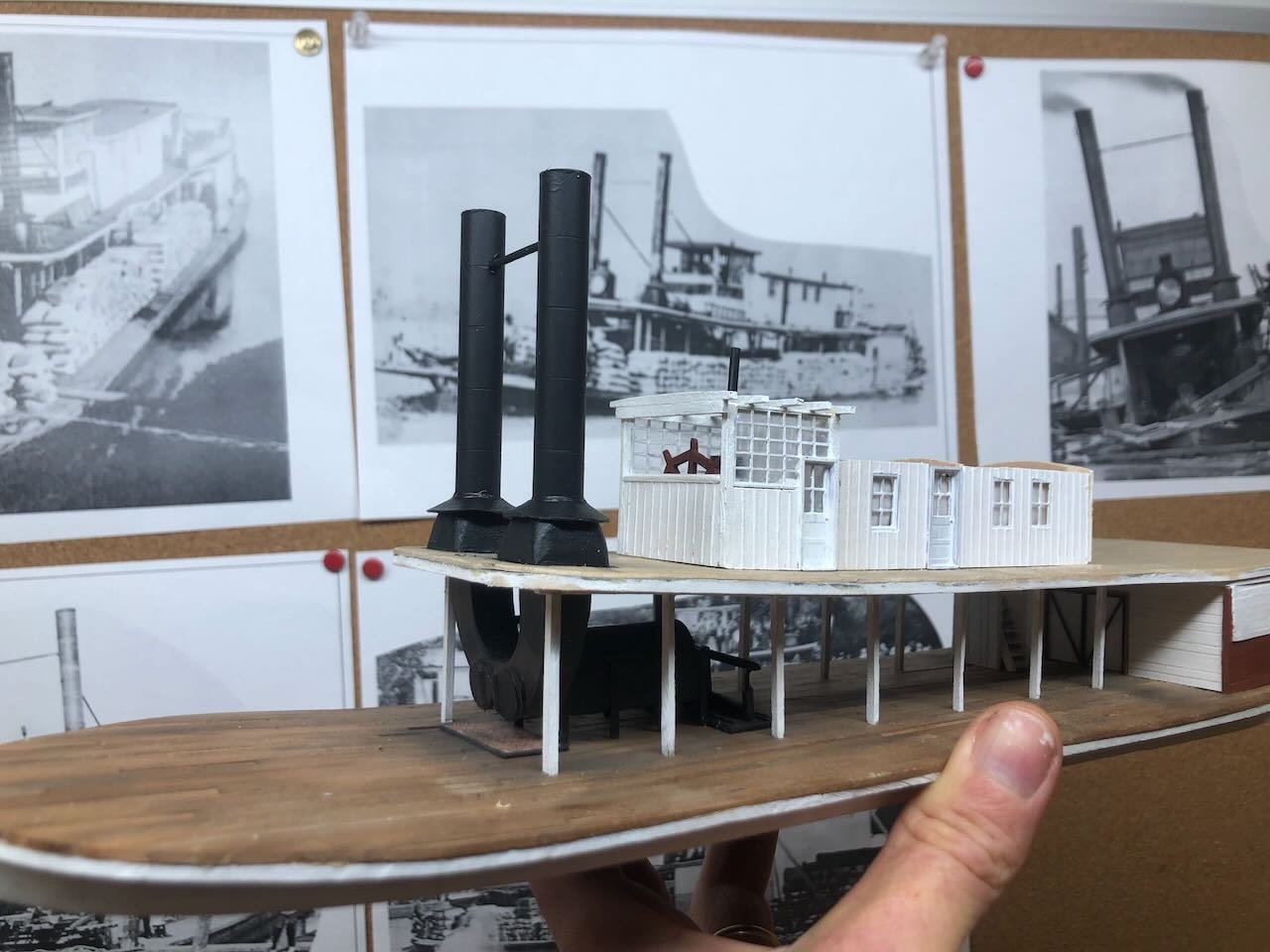
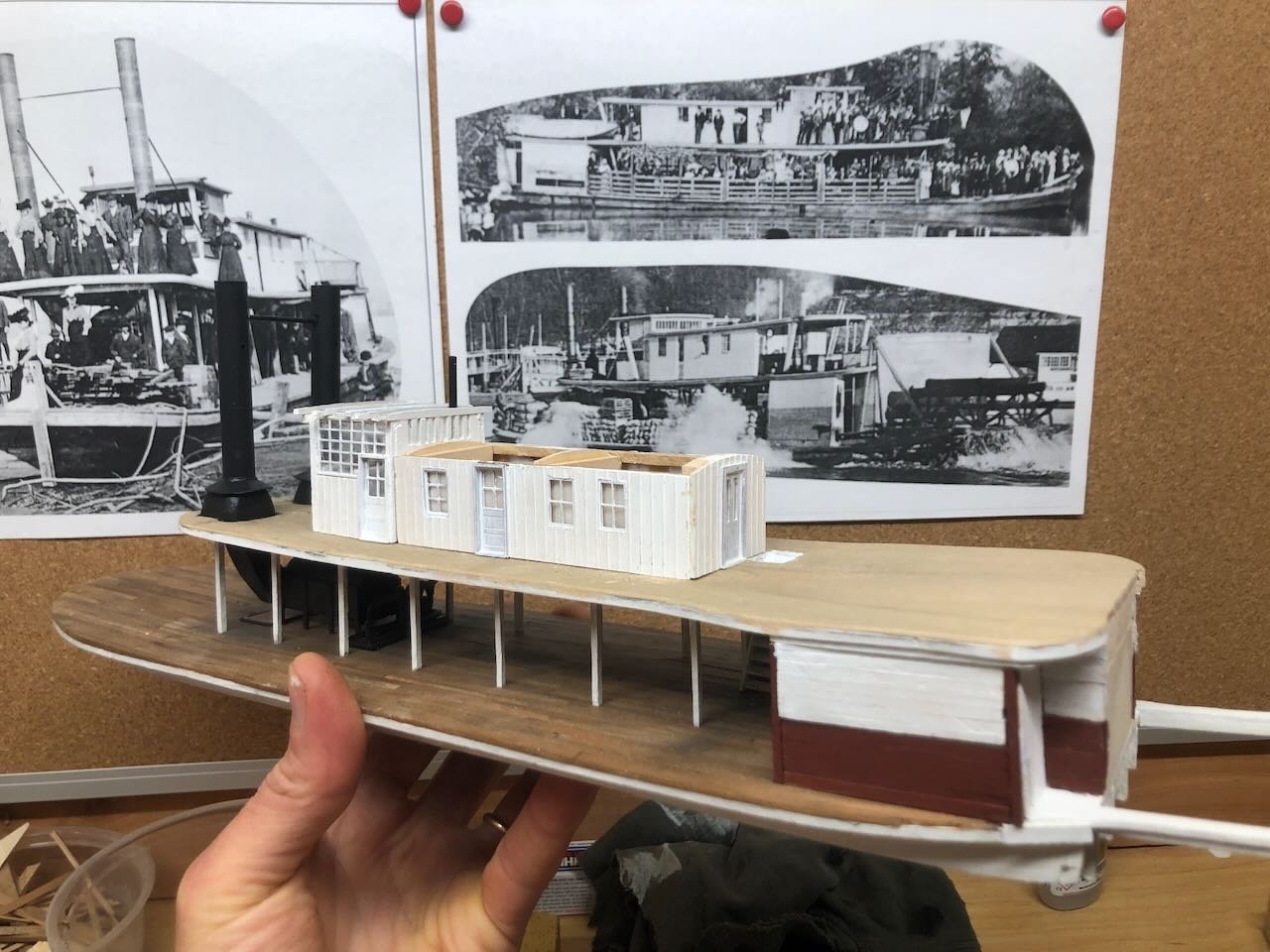
It's been stressful around here lately and I needed a simple project that didn't require too much thought. This fit the bill perfectly. Doing the roof should be easy, too. Then I'll mark its location carefully and start laying out the hog chain braces.
Thanks as always for following along and giving feedback, whether through likes or comments. You all keep me going!
-
-
Bienvenido a MSW! I spent a fair amount of time in Chile in 2018 and wrote up a thread on all my maritime explorations. Nothing you probably don't already know but you might enjoy seeing an outsider's perspective.
The best advice I can give is to start with something simple and build your skills from there. If you get in over your head it can do more harm than good. The complex dream models will still be there when you're ready for them.
-
Sorry for the slow response, I'm catching up on MSW after a busy stretch. You've done such a nice job with this kit, I hope you enjoy displaying it for many years to come. Thanks for sharing the journey with us!
-
On 3/12/2024 at 9:00 AM, brunnels said:
Deep sea sounding wench. Does anyone know if they stored the rope on the wench, or just attached it when in use? Instructions don't show any rope on the wench, and its hard to find any images of deep sea wenches of the period. I think it would look good with some rope wrapped around the drum.
Your work looks lovely, but I feel obliged to point out that it's "winch", not "wench". The latter has a very different meaning that makes the above paragraph unintentionally hilarious (especially the deep sea line)!
- DonSangria and brunnels
-
 2
2
-
Wefalck, I don't have any kind of lathe. In theory I know what you mean, but I wasn't up for trying the old electric drill lathe trick, at least not until all other options had been exhausted.
As it turned out, Brian's method of using cardstock worked like a charm. Much better than the styrene I was trying to use, which didn't want to bend properly and was too thick (the joint stood out like a sore thumb). First I figured out what outside radius I wanted and looked for something to use as a pattern. Turns out a spool of cheap rigging thread from a former kit was perfect. So I traced that outline onto some paper, then traced the inner outline around the right size of brass tubing. This is a basic index card.
Notice that I was sneaky here and folded the stock over to get two comparable discs. Some previous experimentation had convinced me that one layer wasn't stiff enough. So I used the kindergarten trick and cut two out together, making their boundaries more consistent than trying to cut them out separately.
I could have glued the two halves together before cutting, but intentionally didn't. I thought that would make the overlapping joint too thick (more noticeable) and also make the stock stiffer and harder to bend (why the styrene wasn't working). So I spread some glue on one end of the ring, then formed it around the brass tube until I had the angle I wanted:
When both were independently glued up, I smeared glue on one whole surface and sandwiched them together. This worked great, giving me a stiffer final result with the appearance of a single layer (finer joint). I then painted them with thick black paint, which when dry stiffened them even further.
And here they are test-fit on the model. Much better than anything I'd tried before. Lots of internet points for Brian! Any card modelers reading this are shaking their heads and thinking "we could have told you that!".
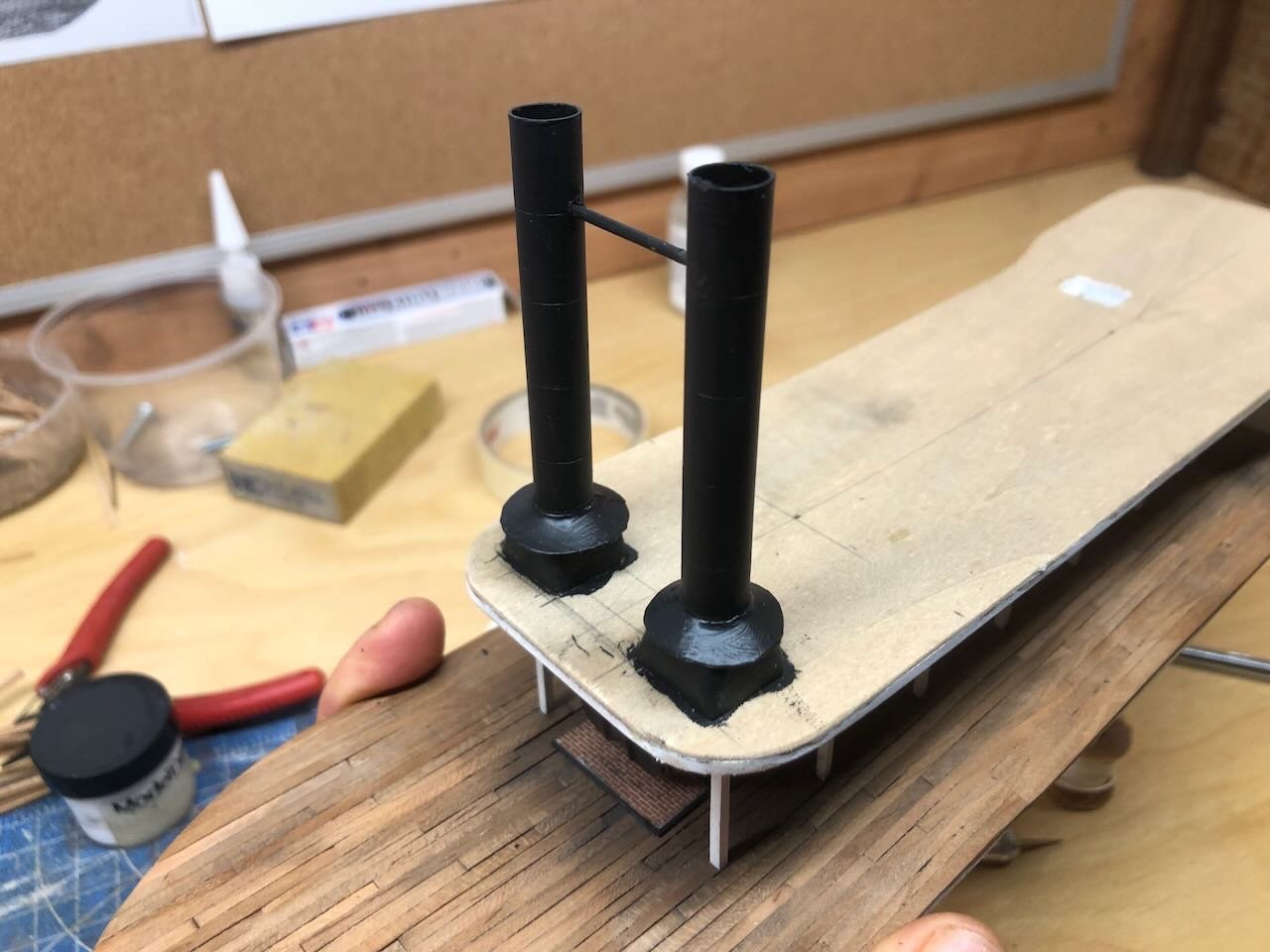
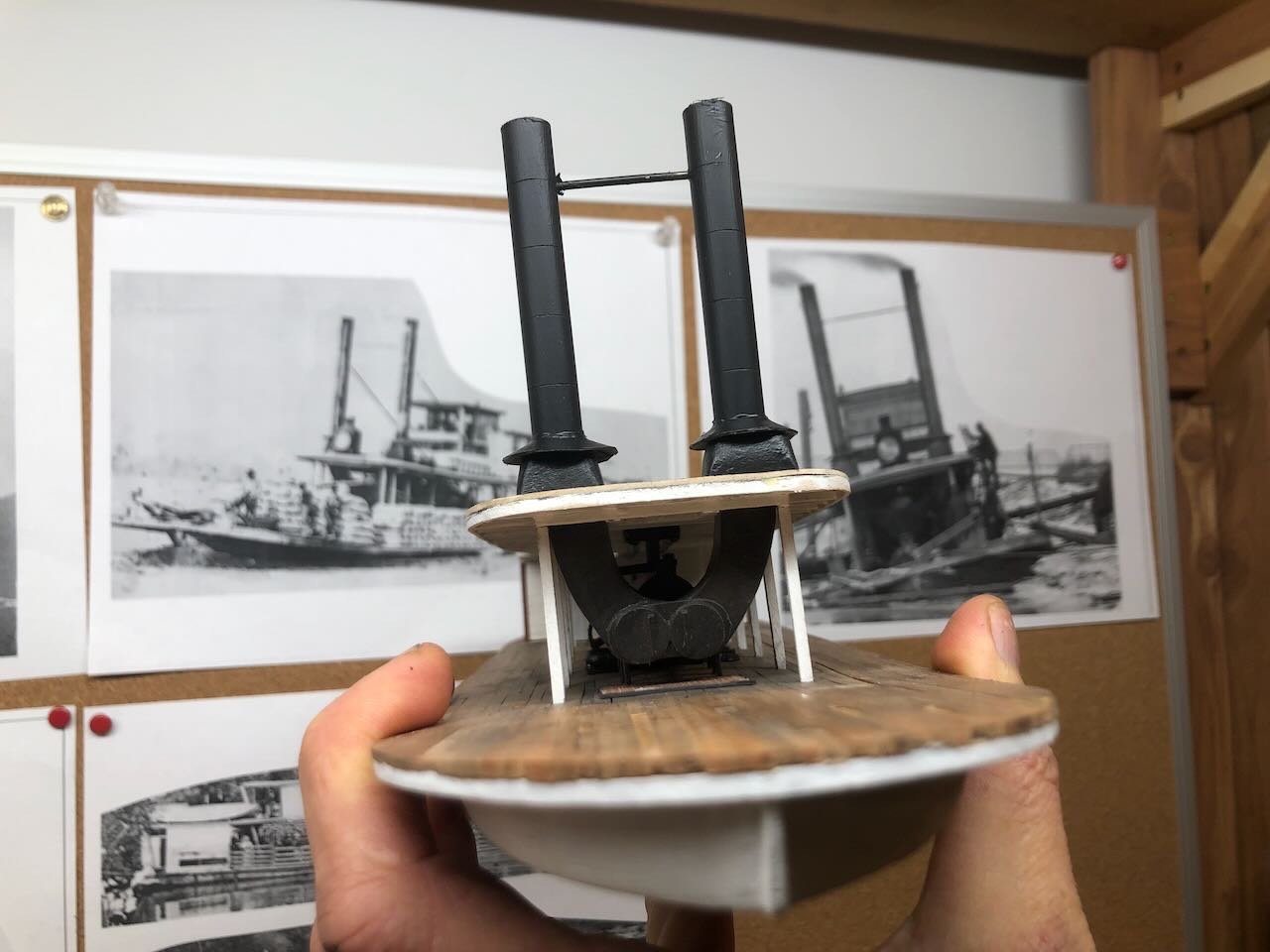
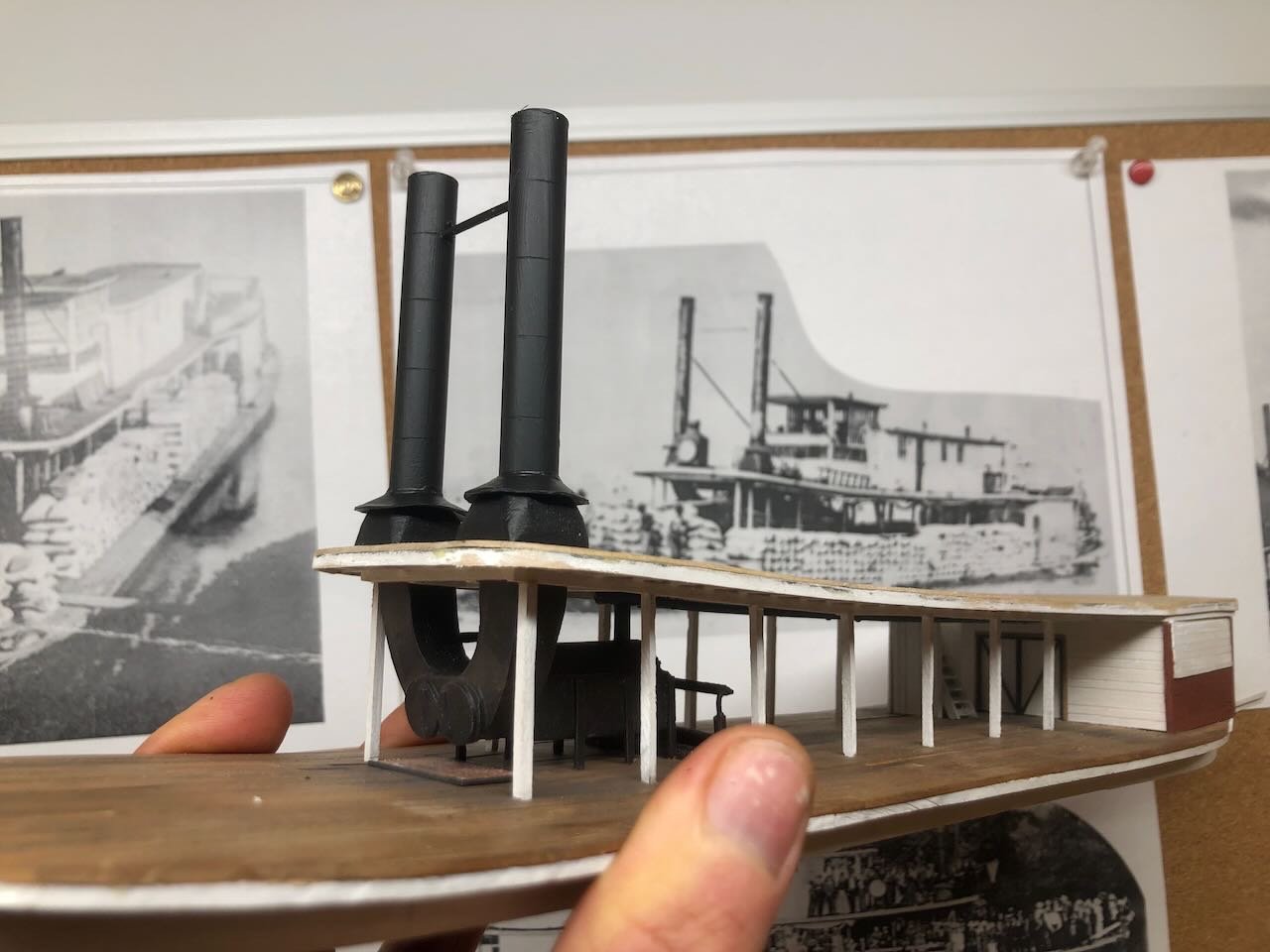
Thanks for the advice! Even when I don't take it or go a different way, it makes me think and helps me learn. Next I need to start laying out the rest of the main cabin, and/or laying out the support posts for the hog chains. We'll see what I feel like doing when I next have time to work on this.
- Knocklouder, Roger Pellett, Canute and 14 others
-
 16
16
-
 1
1
-
-
Wefalck, thanks, I'd figured that out in theory but was struggling with putting it into practice. I'll definitely try Brian's method with card stock. I'd tried thin styrene but it didn't cut or fold cleanly enough. And thanks for the pictures, I'm also very visual.
- Canute, FriedClams, Jack12477 and 3 others
-
 6
6



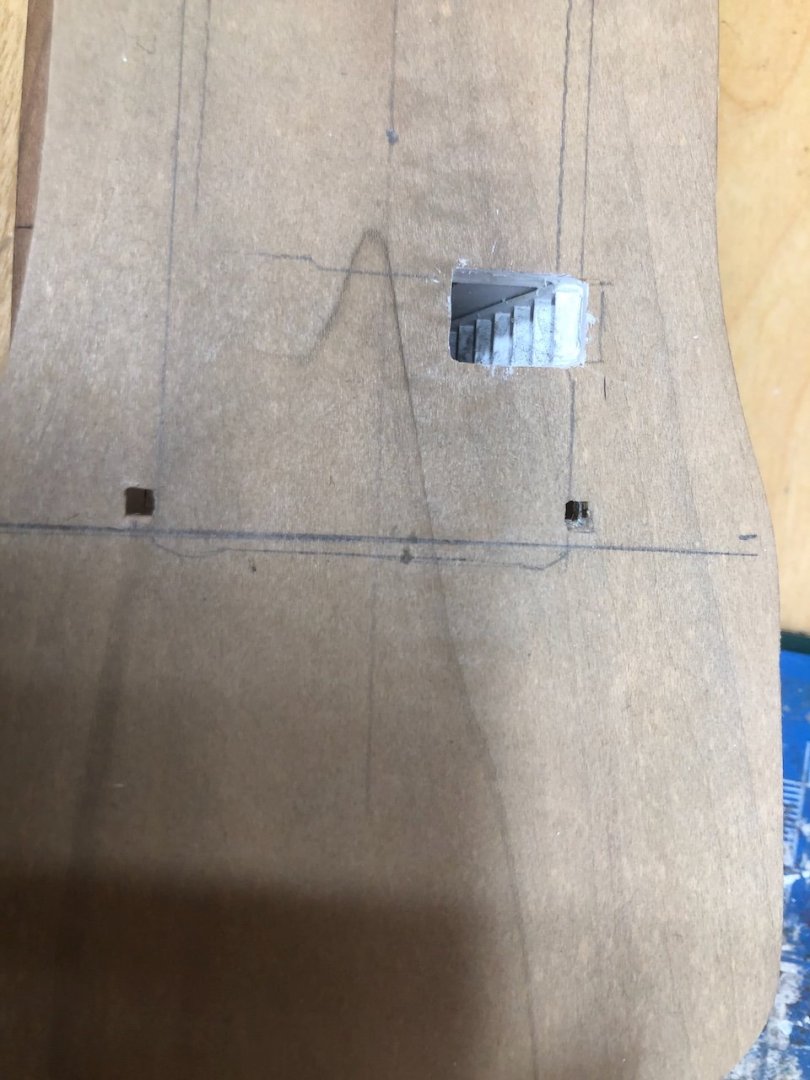
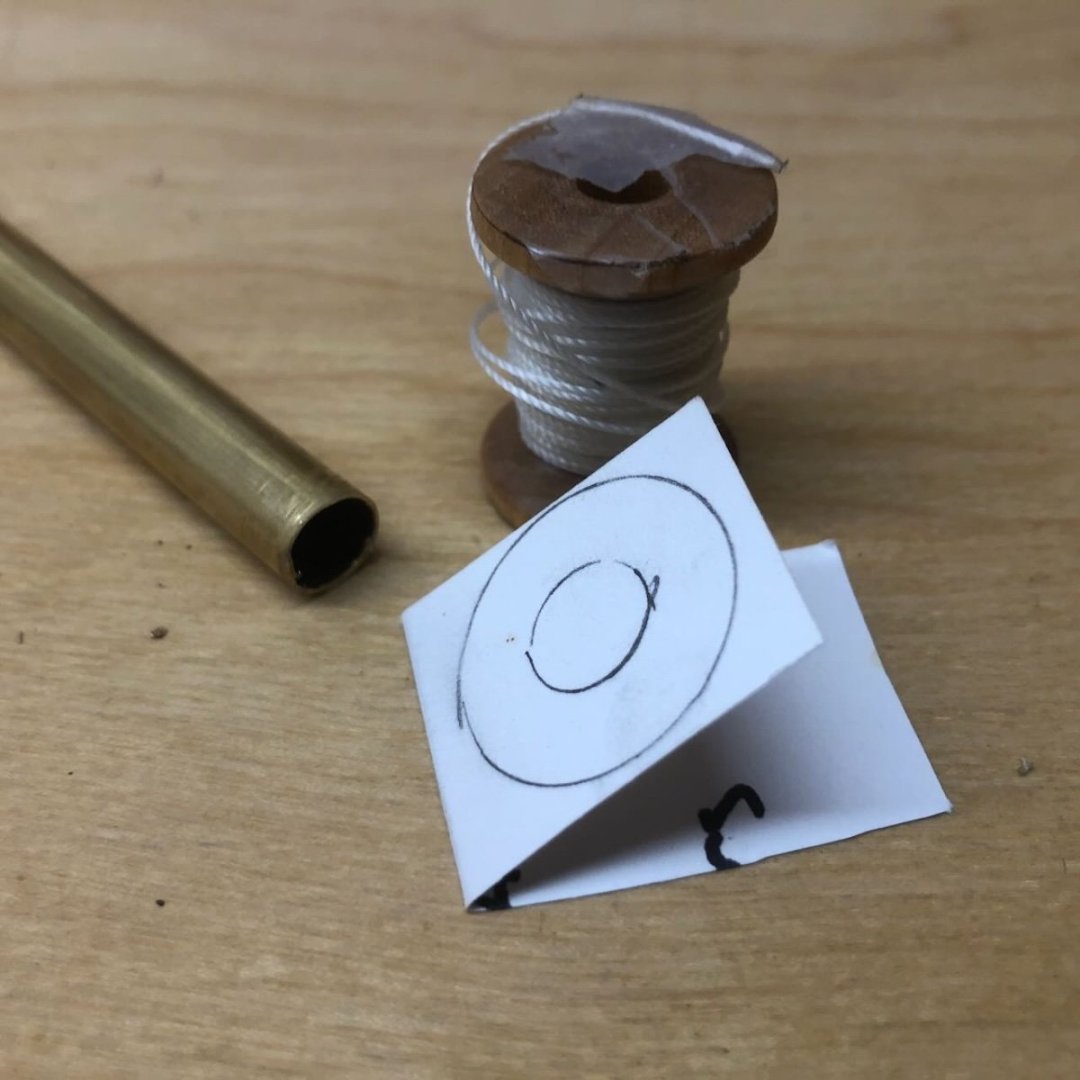
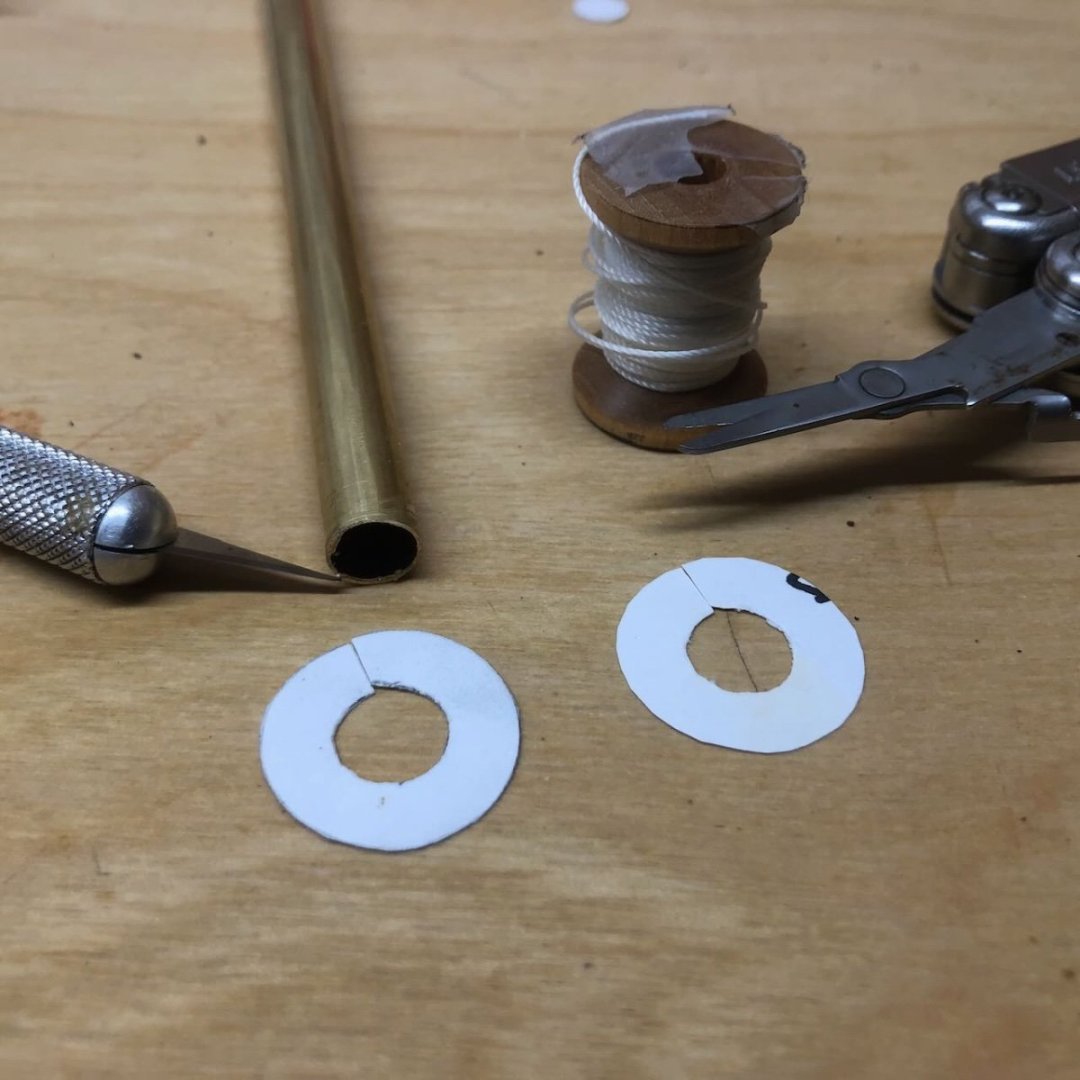
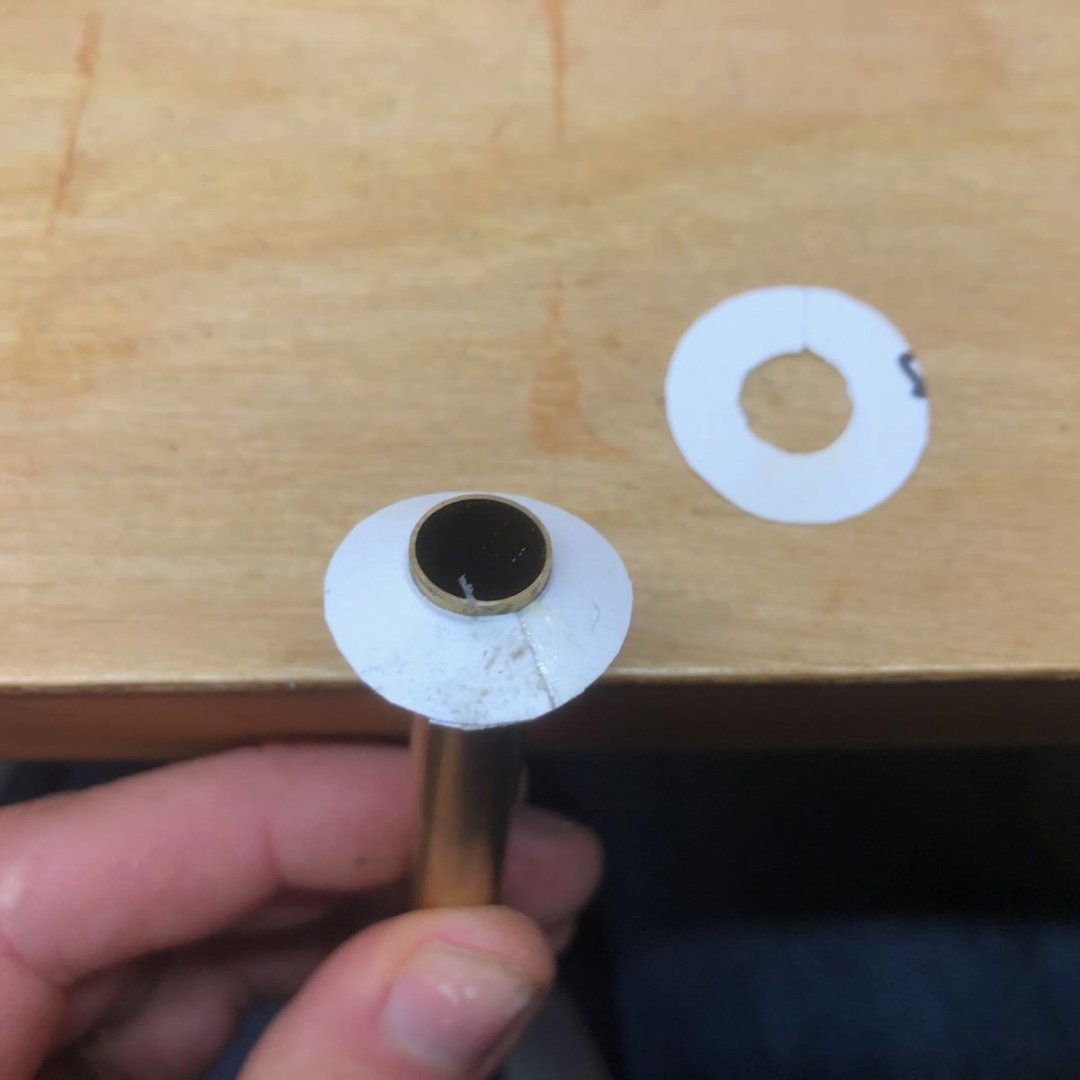
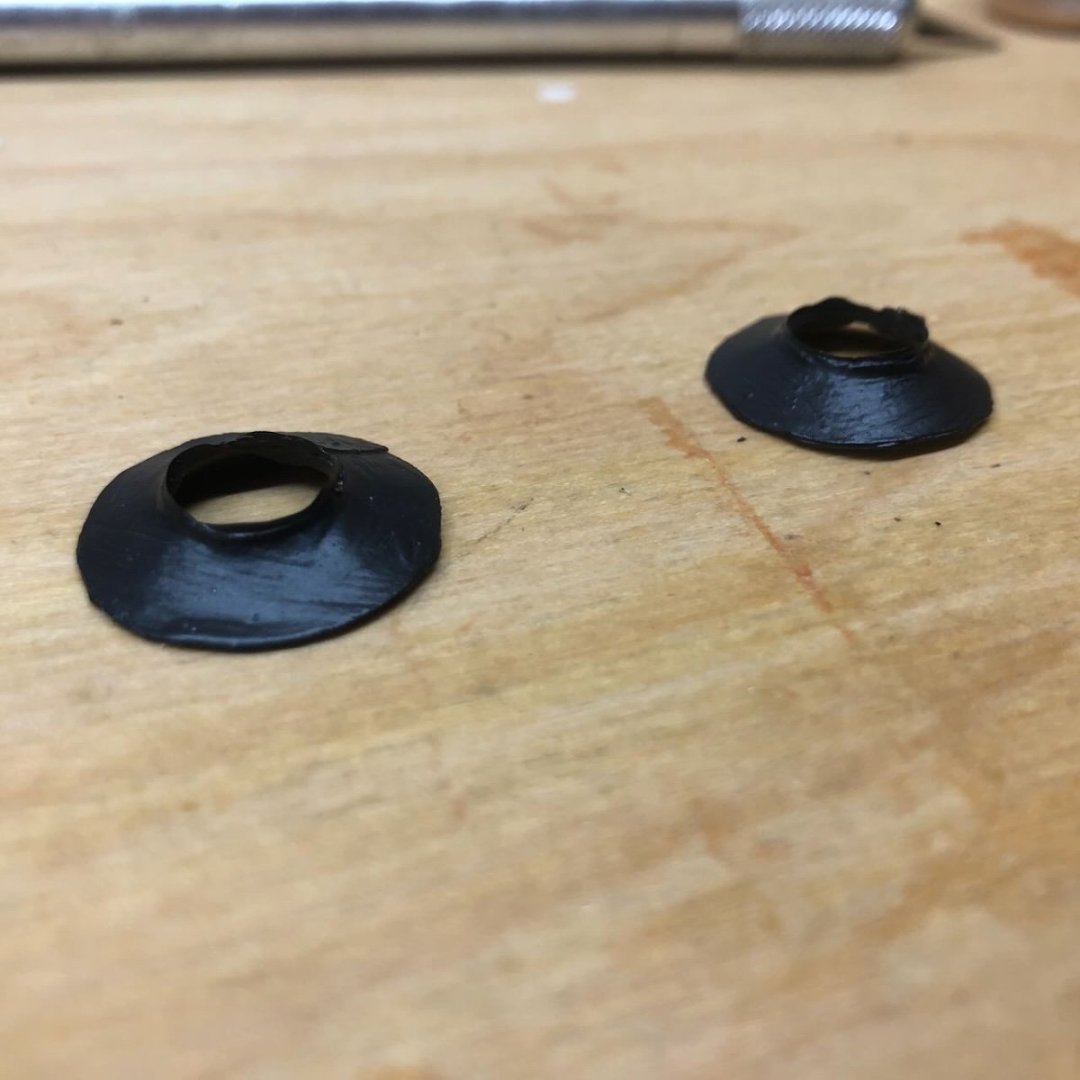
Roar Ege by Scottish Guy - Billing Boats - 1:25
in - Kit subjects built Up to and including 1500 AD
Posted
Those instructions are startlingly bad for an American manufacturer. Not because Americans are any better than anyone else, but because the English in there reads like the non-native gibberish normally encountered in badly translated foreign manuals.
You're doing a good job of being persistent and developing new and interesting ways to meet the kit's challenges.